Rock River Valley Chapter of the Studebaker Drivers Club
Our Charter, Keeping the Studebaker Marque Alive
|
 |
|
|
 |
|
|
|
|
1927 to 1942 Studebaker Commanders
1927 1928GB 1928GH 1929/30GJ 1929/30FD 1931 1932 1933 1934 1935 1938 1939 1940 1941 1942
To go directly to the information on any year, click on the link above
| Table of Specifications for Pre-War Commanders |
| Model Year |
Model |
No. of Cyl's |
Bore/Stroke |
Displacement |
Max. HP |
Wheel Base |
Serial Numbers |
Engine Numbers |
Model Production |
SCAC Model Production |
|
|
|
|
|
|
|
|
|
|
|
| 1927 |
EW |
6 |
3 7/8 x 5 |
353.8 |
75 |
120 |
4,000,001 – 4,039,800 SB |
EW-1 to 40,700 |
40,668 |
40,668 |
| 1,954,401 – 1,955,391 CAN |
| 1928 |
GB |
6 |
3 7/8 x 5 |
353.8 |
85 |
120 |
4,039,801 – 4,062,100 SB |
GB-1 to 22,900 |
22,848 |
22,848 |
| 4,955,401 – 4,956,050 CAN |
| 1928 |
GH |
6 |
3 7/8 x 5 |
353.8 |
85 |
121 |
4,062,101 – 4,070,500 SB |
GH-1 to 8,450 |
8,428 |
8,428 |
| 4.956,051 – 4,956,214 CAN |
| 1929/30 |
GJ |
6 |
3 3/8 x 4 5/8 |
248.3 |
75 |
120 |
4,070,501 – 4,086,041 SB |
GJ-1 up |
15,541 |
16,019 |
| 4,956,301 – 4,956,904 CAN |
| 1929/30 |
FD |
8 |
3 1/16 x 4 ¼ |
250.4 |
80 |
120 |
8,000,001 – 8,025,000 SB |
FD-1 up |
24,331 |
24,639 |
| 8.950,001 – 8,950,500 CAN |
| 1931 |
70 |
8 |
3 1/16 x 4 ¼ |
250.4 |
101 |
124 |
8,025,001 – 8,036,000 SB |
C-101 to 12,000 |
|
10,831 |
| 8,950,501 – 8,950,700 CAN |
| 1932 |
71 |
8 |
3 1/16 x 4 ¼ |
250.4 |
101 |
125 |
8,036,001 – 8,040,000 SB |
C-12,001 to 16,100 |
|
3,351 |
| 8,950,701 – 8,950,800 CAN |
| 1933 |
73 |
8 |
3 1/16 x 4 |
236 |
100 |
117 |
8,040,001 – 8,043,781 SB |
C-16101 to 19,950 |
3,841 |
3,841 |
| 8,950,801 – 8,951,000 CAN |
| 1934 |
B |
8 |
3 1/16 x 3 ¾ |
221 |
103 |
119 |
8,045,001 – up SB |
C-20,001 up |
|
10,315 |
| 8,951,001 – 8,951,200 CAN |
| 1935 |
1B |
8 |
3 1/16 x 4 ¼ |
250.4 |
107 |
119 |
8,103,000 – up SB |
C-30,501 up |
|
6,085 |
| 8,951,201 – up CAN |
| 1938 |
7A |
6 |
3 5/16 X 4 3/8 |
226.2 |
90 |
116 ½ |
5,582,001 – up SB |
H-101 up |
|
19,260 |
| 5,857,501 – up LA |
| 1938 |
8A |
6 |
3 5/16 X 4 3/8 |
226.2 |
90 |
116 ½ |
4,090,001 – up SB |
|
| 4,800,001 – up LA |
| 1939 |
9A |
6 |
3 5/16 X 4 3/8 |
226.2 |
90 |
116 ½ |
4,110,001 – up SB |
H-42,501 up |
|
43,724 |
| 4,802,301 – up LA |
| 1940 |
10A |
6 |
3 5/16 X 4 3/8 |
226.2 |
90 |
116 ½ |
4,148,501 – up SB |
H-87,601 up |
34,502 |
34,437 |
| 4,807-601 – up LA |
| 1941 |
11A |
6 |
3 5/16 X 4 3/8 |
226.2 |
94 |
119 |
4,178,801 – up SB |
H-122,201 |
|
41,996 |
| 4,811,901 – up LA |
| 1942 |
12A |
6 |
3 5/16 X 4 3/8 |
226.2 |
94 |
119 |
4,216,501 – up SB |
H-164,301 up |
|
17,500 |
| 4,818,601 – up LA |
|
|
|
|
|
|
|
|
|
|
|
| The first nine columns are from STCS (Studbaker the Complete Story). [Grey] Model Production is calculated from the serial number allocation (when available), however there is no guarantee that every serial number was actually produced. [Blue] The author does not know the source of SCAC (Standard Catalog of American Cars) production numbers, but in most cases the numbers somewhat match the serial number allocation. |
Prelude:
The
sources used for preparing these pages for the Studebaker Per-war
Commander are “Studebaker the Complete Story” (STCS) by William
A. Cannon and Fred K. Fox; the online “The Classic Car Database”
(TCCD); the SCAC (Standard Calalog of American Cars); and Crestline's
“Studebaker Cars” (CSC) by James H. Moloney. Also, several
Turning Wheel articles written by feature writer Fred Fox. For
source references (STCS), (TCCD), (SCAC) and (CSC) will be used.
The
Studebaker Pre-war Commander's, like the Dictator's, were in
production during one of the most prolific changes the automobile
industry
would ever see. To avoid a repeat of this discussion see the
Dictator page for more information. http://www.rrvcsdc.org/1927-to-1937-Dictator.php
For all the tables included at the end of each yearly model, the following conditions exist for that data.
When data was available from TW or STCS (Studebaker the Complete Story) it is used. Else, TCCD (The Classic Car Database) & SCAC (The Standard Catalog of American Cars) is used. →Information found between the arrows is from Turning Wheel feature articles written by Fred Fox← What we can be fairly sure of is that the same body styles, depending on the source, were sometimes listed in different terms. SB= South Bend, LA= Los Angles, and CAN= Canada
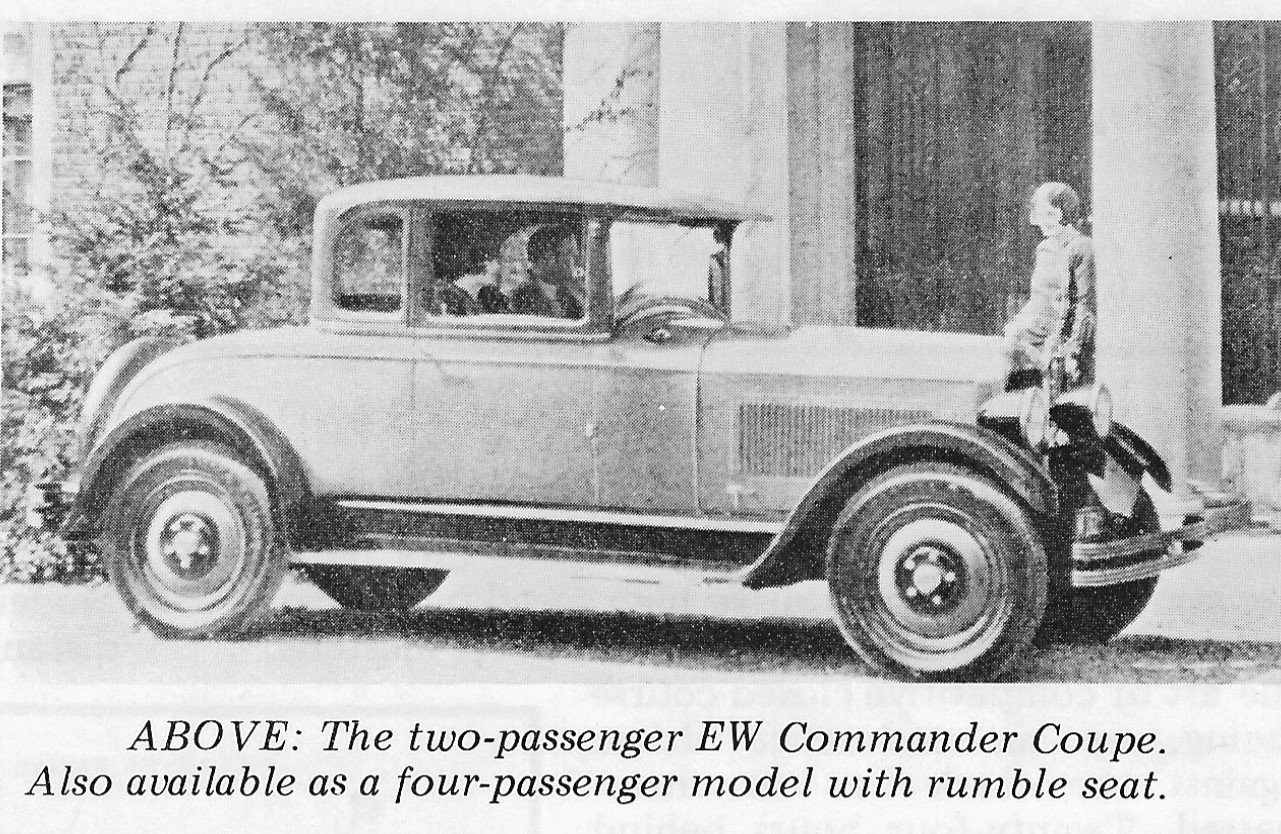 The EW
Big Six was released in January of 1927. It would replace the 120
inch wheelbase ES Big Six which had been in production since
mid-1926. According to William Cannon , the Studebaker service
bulletins for January, February, and March 1927, still referred to
the EW as a Big Six. There was no April service bulletin, but the
May service bulletin references the Commander name for the first
time. However, the April 1927 “Studebaker Wheel” describes the
“Commander” as the latest member of the famous Big Six family. But to further complicate the issue, an ad copy issued February 16th,
1927, Studebaker announces several prices cuts, it included the
“Commander Big Six Brougham”. So, the exact time, the name
changed to Commander, is unknown but did happen early in 1927, with
the EW Model. The EW
Big Six was released in January of 1927. It would replace the 120
inch wheelbase ES Big Six which had been in production since
mid-1926. According to William Cannon , the Studebaker service
bulletins for January, February, and March 1927, still referred to
the EW as a Big Six. There was no April service bulletin, but the
May service bulletin references the Commander name for the first
time. However, the April 1927 “Studebaker Wheel” describes the
“Commander” as the latest member of the famous Big Six family. But to further complicate the issue, an ad copy issued February 16th,
1927, Studebaker announces several prices cuts, it included the
“Commander Big Six Brougham”. So, the exact time, the name
changed to Commander, is unknown but did happen early in 1927, with
the EW Model.
The EW
is so much like the ES model, the differences are nearly
indistinguishable, except for the fact all EW's used disc wheels with
five stud nuts. Neither wood wheels or wire wheels will fit, because
of Studebaker's change to four wheel brakes, this problem would be
fixed in 1928 with a redesign of the front axle. The list below
outlines the improvements that came with the Model EW.
-
Weight
reduction results in better performance.
-
Lighter
front axle with plain bearings replacing the roller bearing in the
knuckles.
-
Redesigned
steering gear.
-
Wheels
are changed from 22 inches to 21 inches.
-
Oil
capacity reduced to 6 and ½ quarts.
-
Semi-automatic
spark control w/lever on the instrument panel.
-
Stromberg
carburetor replaces Ball & Ball carburetor.
-
Manifold
heat control on instrument panel, rather then on the intake
manifold.
-
Transmission
and rear axle lighter, but of equal strength.
-
Smaller
brakes, equally effective because of the weight reduction.
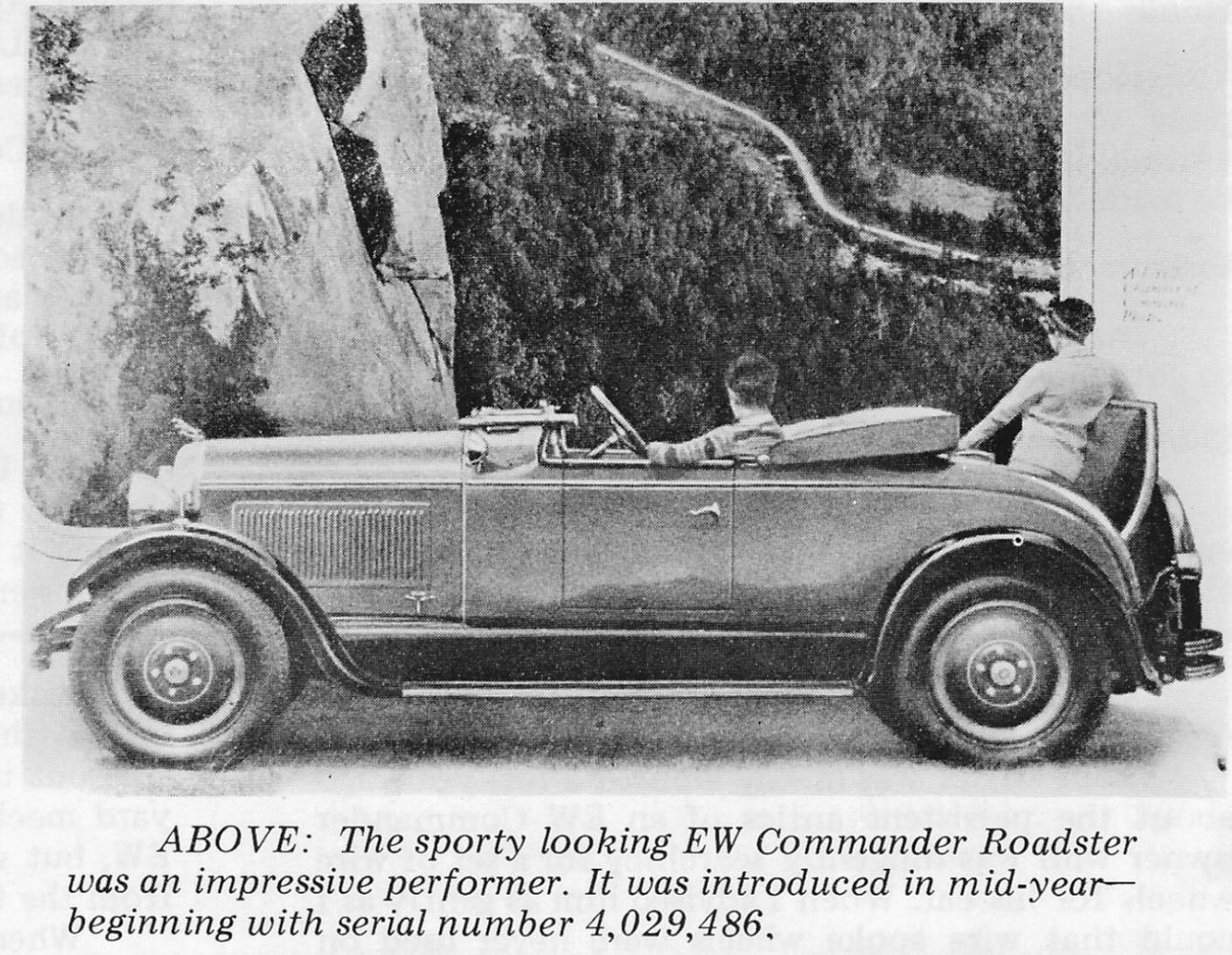 Price
reduction was also a large factor in the success of the EW series. Where a ES Brougham had Price
reduction was also a large factor in the success of the EW series. Where a ES Brougham had been priced at $1,985, the EW started at
$1,785, was reduced to $1,585 in February, and further reduced to
$1,485 in September. been priced at $1,985, the EW started at
$1,785, was reduced to $1,585 in February, and further reduced to
$1,485 in September.
EW Body
types were Sedan (Brougham), (Custom) Coupe, (Custom) Coupe w/rumble
seat, Victoria, (Chancellor) Victoria, and Sport Roadster. Later in
the year, the Sedan and Victoria were available in Regal Trim.
Side Bar one: It
should be noted that Studebaker at this time used the term “Brougham”
interchangeable with “Sedan”. In the carriage and early
horseless carriage days a “Brougham” contained a separate closed
cabin for the passengers, while the driver remained outside. But
later it [Brougham] defined a model where the driver and passengers
were in the same cabin, but usually denoting a higher level of
luxury.
The Chancellor name however, did indicate a more luxurious
interior with a vanity case and deluxe hardware.
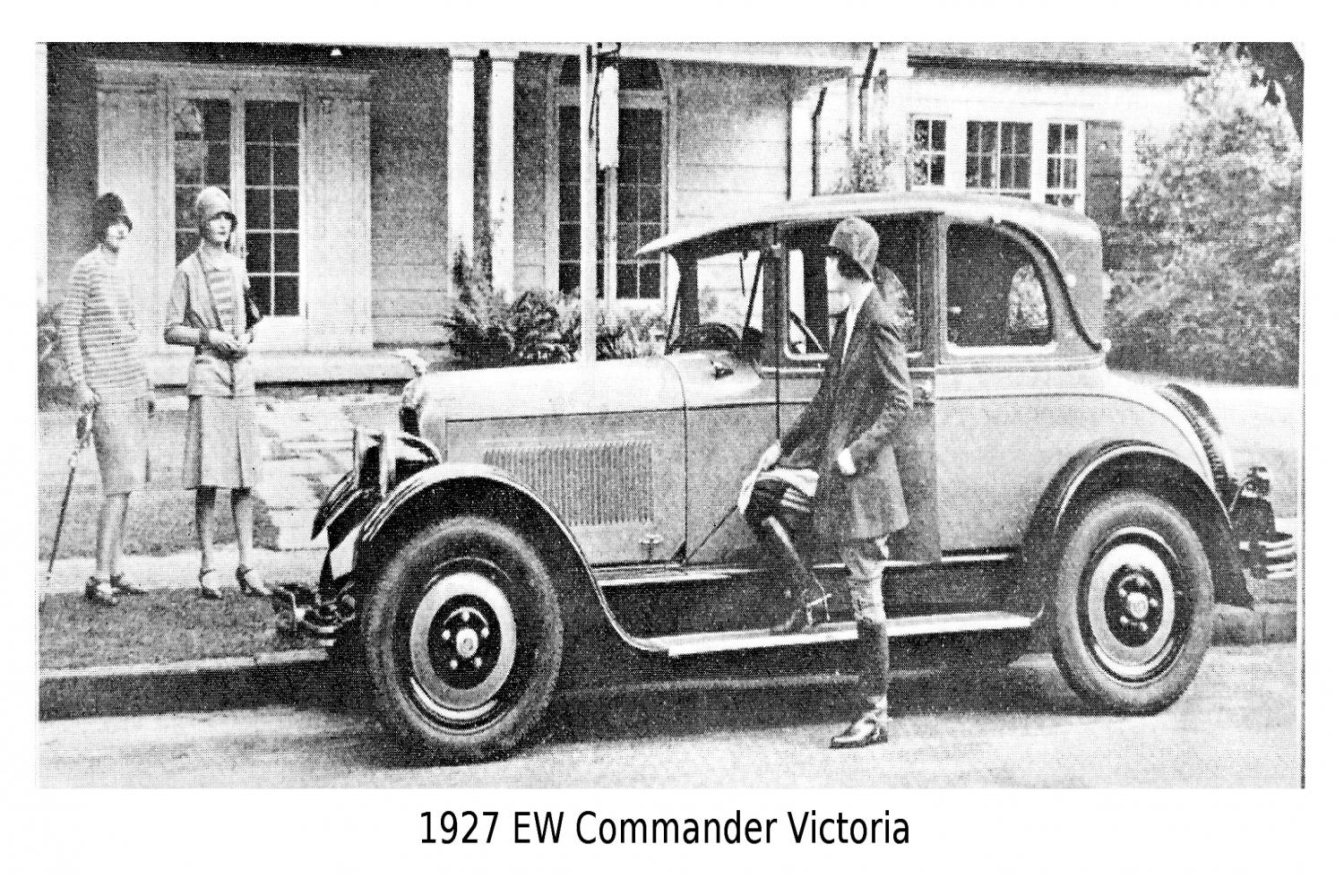 EW
running changes were many, but the major visible changes are when the
radiator shell changed from nickel to chrome and from the rounded
design to the flatter design. Headlights were initially black and
nickel bullet-shaped, except all nickel on the Chancellor, until the
radiator shell change. After the radiator change, the headlights
were black with chrome on regular cars and all chrome on Regal trim
cars. A second type “Acorn Style” headlights may have been used
on some late production cars. All EW's used the torpedo type cowl
lights except the later Regal cars, which mostly likely changed with
the introduction of chrome, to EW
running changes were many, but the major visible changes are when the
radiator shell changed from nickel to chrome and from the rounded
design to the flatter design. Headlights were initially black and
nickel bullet-shaped, except all nickel on the Chancellor, until the
radiator shell change. After the radiator change, the headlights
were black with chrome on regular cars and all chrome on Regal trim
cars. A second type “Acorn Style” headlights may have been used
on some late production cars. All EW's used the torpedo type cowl
lights except the later Regal cars, which mostly likely changed with
the introduction of chrome, to
an 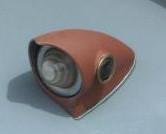 Acorn type. The instrument panel
also changed from an oval design to the gothic design at the same
time as the change from nickel to chrome. Acorn type. The instrument panel
also changed from an oval design to the gothic design at the same
time as the change from nickel to chrome.
Most
of the information above was gleaned from an article written by Bill
Cannon in “The Antique Studebaker Review” Vol 17 NO. 3 Names
contained within the () came from Cannon and differ from the TW's
articles written by Fox, and the model names in the charts below.
Tell's
for 1927 EW: Double-bar fluted
bumpers, Atalanta radiator
mascot, and five stud disc wheels.
Side
Bar Two: The Victoria, while
using two doors and looking much like a coupe, has a back seat. Entrance is gained to the back seat, by folding the front passenger
seat forward. The rear window is much larger then the Coupes and it
has a Landau bar 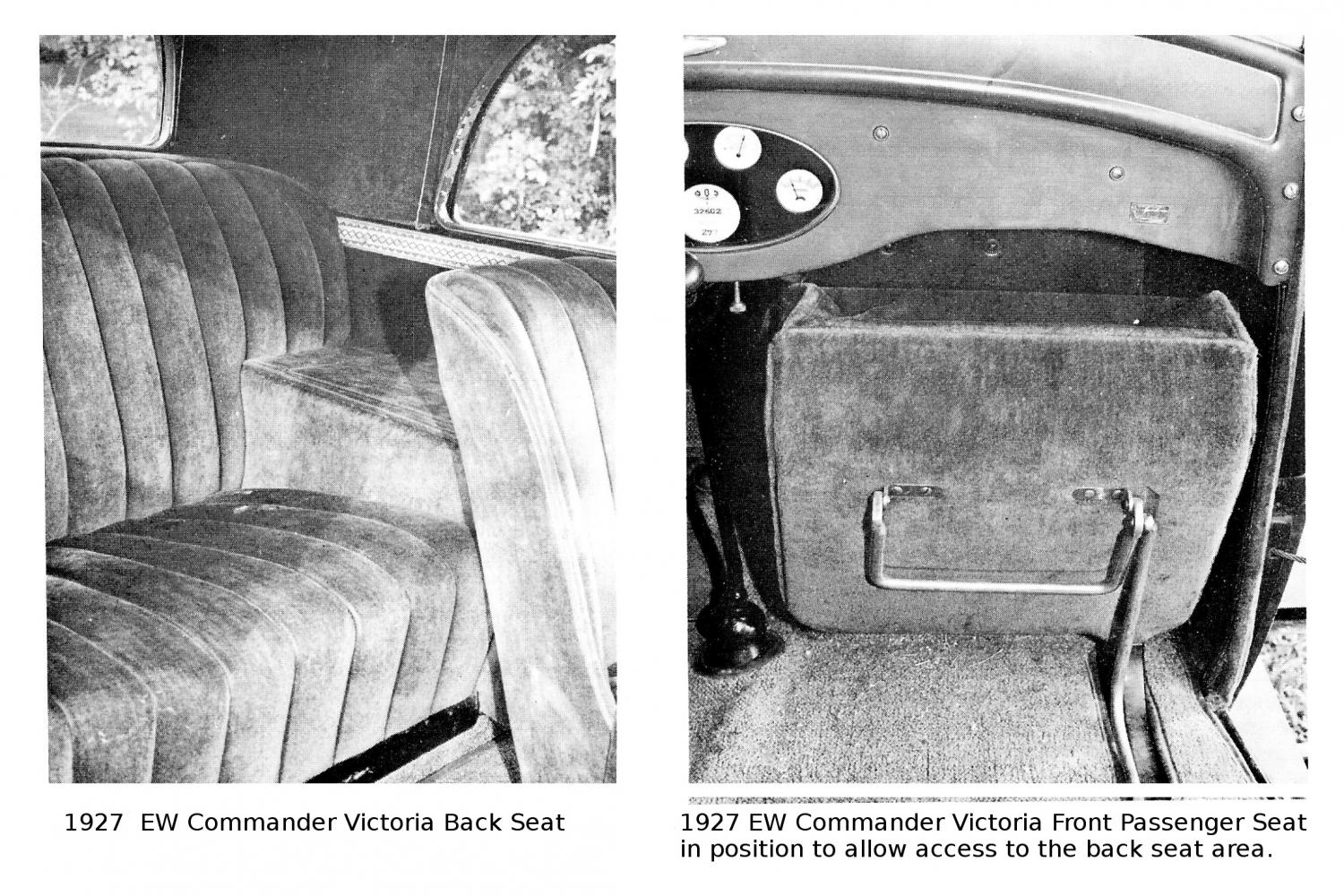 above that window. The Victoria had much richer
appointments. The EW Victoria for some unknown reason used a
different bumper (Biflex) then all the rest of the EW's which used
the Eaton double-bar fluted bumpers. above that window. The Victoria had much richer
appointments. The EW Victoria for some unknown reason used a
different bumper (Biflex) then all the rest of the EW's which used
the Eaton double-bar fluted bumpers.
Ref: “The Prewar Commanders, 1927 – 1942 Part 1: Model; EW” [ASR,
William Cannon].
During
1927 a multitude of performance and endurance records were set with
the use of Studebaker Commander's. This topic is to extensive to
cover here.
| When data was available from TW or STCS (Studebaker the Complete Story) it is used. Else, TCCD (The Classic Car Database) & SCAC (The Standard Catalog of American Cars) is used. →Information found between the arrows is from Turning Wheel feature articles written by Fred Fox← What we can be fairly sure of is that the same body styles, depending on the source, were sometimes listed in different terms. SB= South Bend, LA= Los Angles, and CAN= Canada |
| Model |
Doors |
Passenger |
Price |
| 1927 Model EW Commander |
| Sedan 5-Passenger (W) |
4 |
5 |
$1,585.00 |
| Regal Sedan 5-Passenger (W) |
4 |
5 |
$1,785.00 |
| Victoria 5-Passenger (C-R) |
2 |
5 |
$1,575.00 |
| Regal Victoria 5-Passenger (C-R) |
2 |
5 |
$1,645.00 |
| Coupe (Q) |
2 |
2 |
$1,545.00 |
| Coupe w/rumble seat (E) |
2 |
4 |
$1,645.00 |
| Sport Roadster w/rumble seat (J) |
2 |
4 |
$1,675.00 |
| →The EW Model started production in January of 1927 and finished production sometime in October. Studebaker assigned 39,800 SB serial numbers and 991 and CAN serial number to the Model EW. According to Fred Foxes article in TW 40,668 were manufactured, close to the 40,791 serial numbers assigned. Engine Serial Numbers EW-1 up. All the data in this chart comes from Foxes article in TW. April 2004.← In an article from “The Antique Studebaker Review” Bill Cannon names Custom Coupe, Custom Coupe w/rumble seat, and Chancellor Victoria. The term “Custom” may have been used to further denote the car was not in Regal trim, and the Chancellor Victoria and Regal Victoria most likely was the same car. The SCAC and TCCD both mentioned a 2-Door Sports Roadster Duplex and 4-Door Sports Phaeton. |
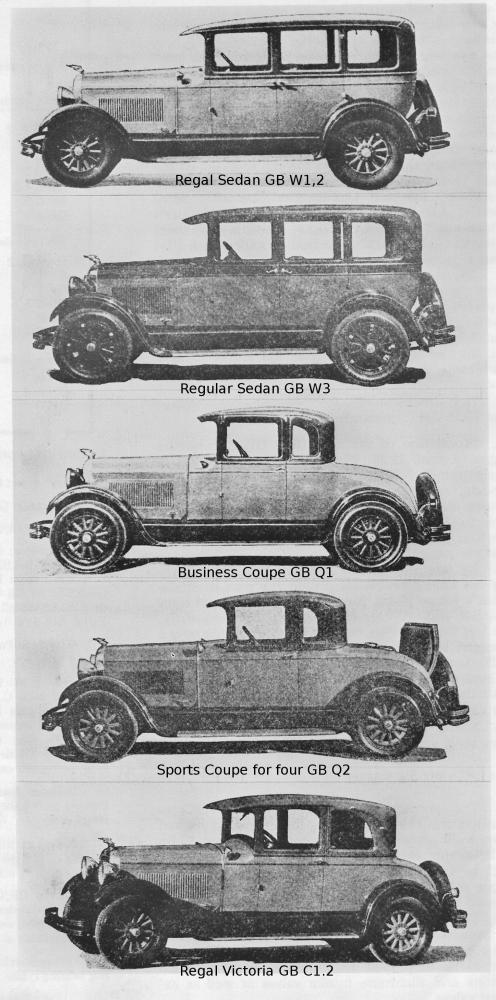 The GB
Commander started production sometime in October of 1927 and ended
with the release of the The GB
Commander started production sometime in October of 1927 and ended
with the release of the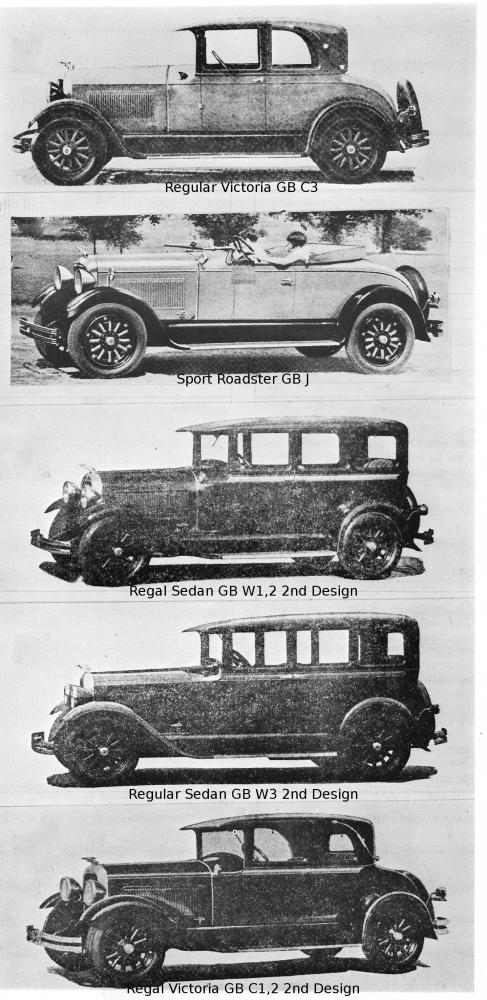 GH Commander's in June of 1928. The GB
Commander was almost identical to the EW, except that as the front
axle had now been redesigned, wooden spoke wheels were standard with
wire wheels or disc wheels, optional at extra cost. A number of
mechanical changes were made as follows. GH Commander's in June of 1928. The GB
Commander was almost identical to the EW, except that as the front
axle had now been redesigned, wooden spoke wheels were standard with
wire wheels or disc wheels, optional at extra cost. A number of
mechanical changes were made as follows.
-
The
spark, throttle, and light switch levers were mounted in the
steering wheel hub.
-
The
steering wheel lock was redesigned, so it could not be engaged when
ignition was on.
-
The
intake manifold heater was controlled by a button in the dash marked
“H”.
-
The
brakes were now Bendix-Perrot three-shoe expanding, both front and
rear.
-
Both the front and rear axles were redesigned,
-
A
Ross cam and lever steering gear was used.
-
The
tire size changed to 5.50 x 20 inches
-
Adjustment
and lubrication of the fan was improved.
-
Fuses
were eliminated in favor of a buzzer type alarm, mounted behind the
instrument panel.
GB
Commander body styles were Regular and Regal Sedans, Business
Coupe, Sports Coupe w/rumble seat, Regular and Regal Victoria, and
Sports Roadster.
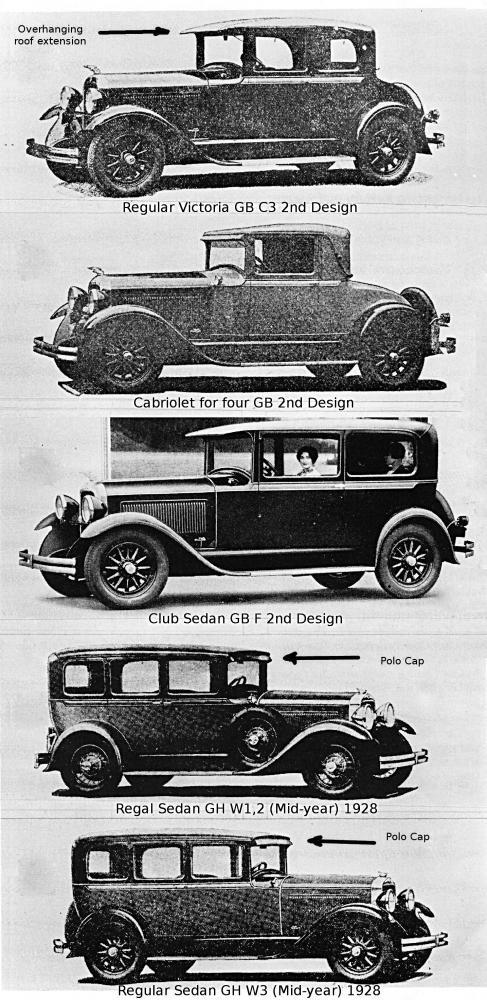 After
about 5,000 GB were produced new bodies were introduced, with longer
and more sweeping, fullcrown, front fenders. A new “World
Champion” emblem was add to the headlight support cross bar, a
contrasting trapezoidal belt line was added, and a new instrument
panel design was introduced. Mechanical changes were minor, but
Monroe hydraulic shock absorbers replace the Wahl spring brakes. These new GB are referred to as 2nd design in the parts
books, where the first GB's are referred to as 1st design
cars. There were no Coupes or Sports Roadsters produced in this 2nd
design. But, a new Cabriolet and two door Club Sedan were
introduced. After
about 5,000 GB were produced new bodies were introduced, with longer
and more sweeping, fullcrown, front fenders. A new “World
Champion” emblem was add to the headlight support cross bar, a
contrasting trapezoidal belt line was added, and a new instrument
panel design was introduced. Mechanical changes were minor, but
Monroe hydraulic shock absorbers replace the Wahl spring brakes. These new GB are referred to as 2nd design in the parts
books, where the first GB's are referred to as 1st design
cars. There were no Coupes or Sports Roadsters produced in this 2nd
design. But, a new Cabriolet and two door Club Sedan were
introduced.
Tell's
for 1928 GB: 1st
design, wooden
spoke wheels and screw on Atalanta
radiator cap. 2nd
design; new trapezoidal belt line
treatment and full crowned
sweeping fenders. The “Commander World's Champion” emblem, is on
the headlamp support bar, and Eaton oval
bar bumper are used.
Side
Bar: The Club Sedan, was essentially the same as the Victoria,
in that it was a two door car. However, the rear window was much
larger and the car was more stretched out. Considering it was
suppose to be the lowest price ever Commander at release, we can
assume it was quite spartan in comparison to the Victoria's very fine
appointments.
Ref:
“The Prewar Commanders, 1927 – 1942 Part 2: Model; GB/GH”
[ASR, William Cannon].
| When data was available from TW or STCS (Studebaker the Complete Story) it is used. Else, TCCD (The Classic Car Database) & SCAC (The Standard Catalog of American Cars) is used. →Information found between the arrows is from Turning Wheel feature articles written by Fred Fox← What we can be fairly sure of is that the same body styles, depending on the source, were sometimes listed in different terms. SB= South Bend, LA= Los Angles, and CAN= Canada |
| Model |
Doors |
Passenger |
Price |
| 1928 Model GB Commander |
| Sedan 5-Passenger (W3) |
4 |
5 |
$1,485.00 |
| Regal Sedan 5-Passenger (W1,2) |
4 |
5 |
$1,625.00 |
| Victoria 5-Passenger (C3) |
2 |
5 |
$1,495.00 |
| Victoria Regal 5-Passenger (C1,2) |
2 |
5 |
$1,625.00 |
| Coupe (Q1) |
2 |
2 |
$1,495.00 |
| Regal Coupe w/rumble seat (Q2) |
2 |
4 |
$1,625.00 |
| Regal Roadster w/rumble seat (J) |
2 |
4 |
$1,595.00 |
| Club Sedan (F) |
2 |
5 |
$1,435.00 |
| Regal Cabriolet w/rumble seat (E) |
2 |
4 |
$1,625.00 |
| → The GB Model started production sometime in October of 1927 and finished production in June of 1928. Studebaker assigned 22,300 SB serial numbers and 650 and CAN serial number to the Model GB. According to Fred Foxes article in TW 22,848 were manufactured, close to the 22,950 serial numbers assigned. Engine Serial Numbers GB-1 up. All the data in this chart comes from Foxes article in TW. April 2004.← In an article from “The Antique Studebaker Review” Bill Cannon names the Coupe a Business Coupe. SCAC and TCCD named the same models. Note: When two numbers are listed as for example (W1,2), they were used to differentiate trim differences, however we do not know what those may have been. |
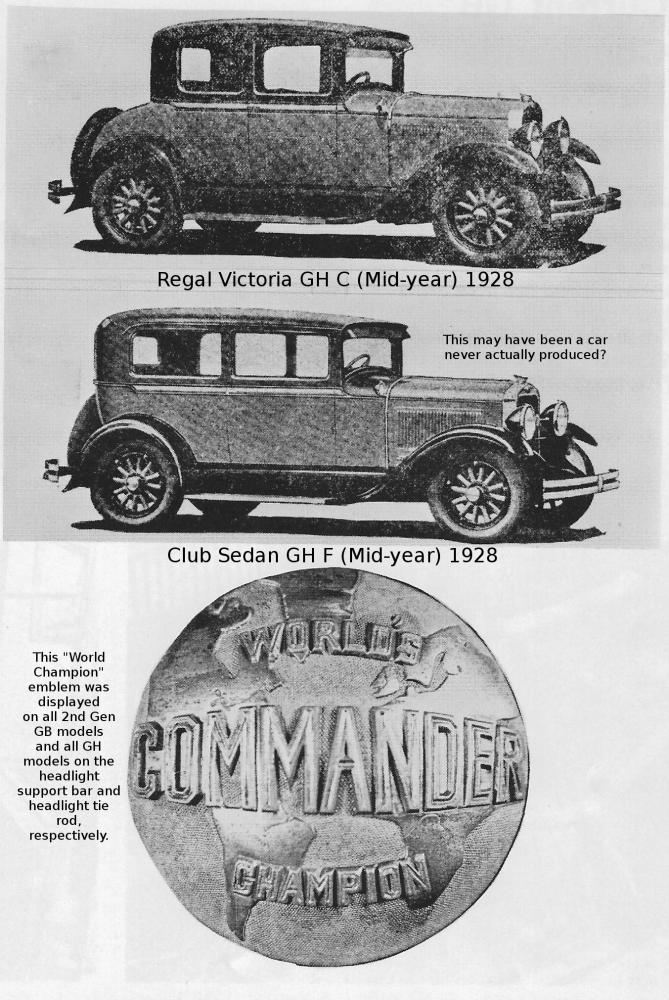 The GH
Commander started production sometime in June of 1928 and ended in
October of 1928. The bodies were extensively redesigned, as was the
entire Studebaker line, few changes were made to the chassis. The GH
Commander's ran on a 121 inch wheel base and Fafnir ball bearing
spring shackles were introduced. Newer and lighter six and eight
engine designs were in the works, consequently the GH Model was only
in production for about five months. The GH
Commander started production sometime in June of 1928 and ended in
October of 1928. The bodies were extensively redesigned, as was the
entire Studebaker line, few changes were made to the chassis. The GH
Commander's ran on a 121 inch wheel base and Fafnir ball bearing
spring shackles were introduced. Newer and lighter six and eight
engine designs were in the works, consequently the GH Model was only
in production for about five months.
Only two
body styles were produced, Sedan and Victoria, in Standard and Regal
form. With the end of GH production, the famous Big Six engine
production would reach an end.
Tell's
for 1928 GH: The
“Commander World's Champion”
emblem is relocated to the
headlamp tie bar. The Atalanta is gone,
in favor of a new winged-motif radiator cap, which was also extended
to the tops of the headlights. The roof
extension visor is replaced by a much shorter “Polo
Cap”.
Ref:
“The Prewar Commanders, 1927 – 1942 Part 2: Model; GB/GH”
[ASR, William Cannon].
| When data was available from TW or STCS (Studebaker the Complete Story) it is used. Else, TCCD (The Classic Car Database) & SCAC (The Standard Catalog of American Cars) is used. →Information found between the arrows is from Turning Wheel feature articles written by Fred Fox← What we can be fairly sure of is that the same body styles, depending on the source, were sometimes listed in different terms. SB= South Bend, LA= Los Angles, and CAN= Canada |
| Model |
Doors |
Passenger |
Price |
| 1928 ½ Model GH Commander |
| Regular Sedan (W3) |
4 |
5 |
$1,495.00 |
| Regal Sedan (W1,2) |
4 |
5 |
$1,665.00 |
| Victoria (C) |
2 |
4 |
$1,545.00 |
| Regal Victoria (C) |
2 |
4 |
$1,625.00 |
| → The GH Model started production sometime in June of 1928 and finished production in October of 1928. Studebaker assigned 8,300 SB serial numbers and 200 and CAN serial number to the Model GH. According to Fred Foxes article in TW 8,428 were manufactured, close to the 8,500 serial numbers assigned. Engine Serial Numbers GH-1 up. All the data in this chart comes from Foxes article in TW. April 2004.← In an article from “The Antique Studebaker Review” Bill Cannon did not list the Regal Victoria. SCAC and TCCD agreed with Cannon and did not list the Regal Victoria. Note: When two numbers are listed as for example (W1,2), they were used to differentiate trim differences, however we do not know what those may have been. |
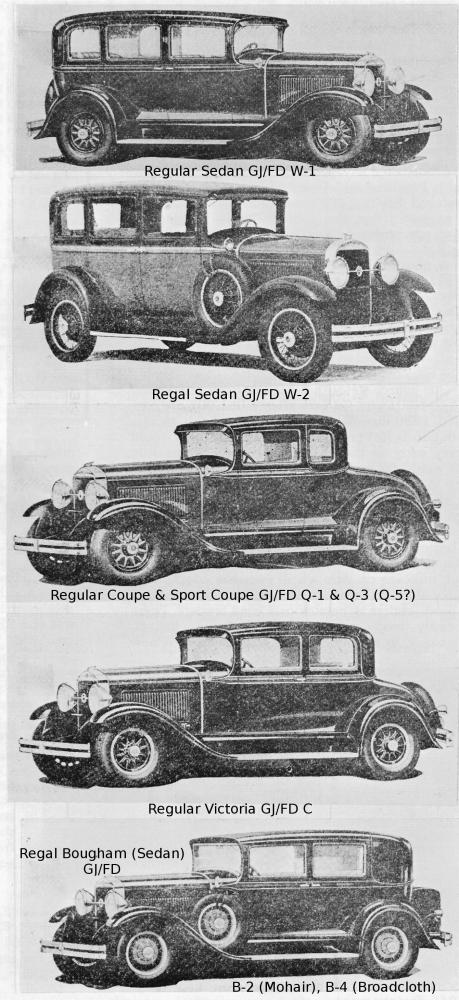 
The
GJ Commander's has a new six cylinder engine, a stroked version of
the Dictator Six (248.3 cu. in.). The new motor puts out 75 HP, but
is 200 pounds lighter. Couple that with an additional 200 pounds of
weight reduction in the rest of the car and the performance is equal
to or better then it was with the previous 85 HP “Big Six”
engine. The styling is very similar to the GH ½ Commander's, but
the bodies are slightly wider and lower, sitting on a new double-drop
frame. The belt line is changed, the “A” pillar is curved
instead of vertical, and the wheel base is back to 120 inches. The
GJ Six and the FD Eight are identical, other then the motors, using
the same transmission, clutch, and drive train. The only external
sign is the emblem found on the headlight cross-bar, using an “8”
for the FD and a “6” for the GJ. Otherwise you cannot tell the
difference, unless you open the hood. The windshields now have
safety glass.
Body styles are Sedan, Brougham (Mohair B2 or
Broadcloth B4), Victoria, Convertible Cabriolet, Business Coupe,
Coupe w/rumble seat, Roadster, and Tourer. The Brougham and
Convertible were only offered in Regal trim. The coupes were added
in March 1929 in regular trim as either GJ or FD models. Any
regular Coupe, Sedan, Victoria, Roadster, or Tourer could be switched
to five wire wheels for $60.00. In April 1929 the 5 Passenger and 7
Passenger Tourer, in Regular and Regal trim, were added, very few
were made. The only GJ model to lack the polo cap style visor was
the Brougham with it's “French Front”.
Tells
for GJ & FD: Curved
rather then straight “A” pillar,
the trapezoidal belt line was gone, replaced by a belt
line that was squared off in the
back and finished with a point at
the cowl. New 6 & 8 emblems
on the headlight bar and a much
lower stance.
Ref:
TW Nov. 2008 Feature Article “Studebaker's 1929-30 GJ & FD
Commander's” by Fred Fox
| When data was available from TW or STCS (Studebaker the Complete Story) it is used. Else, TCCD (The Classic Car Database) & SCAC (The Standard Catalog of American Cars) is used. →Information found between the arrows is from Turning Wheel feature articles written by Fred Fox← What we can be fairly sure of is that the same body styles, depending on the source, were sometimes listed in different terms. SB= South Bend, LA= Los Angles, and CAN= Canada |
| Model |
Doors |
Passenger |
Price |
| 1929/1930 Model GJ Commander |
| Regular Sedan 5-Passenger (W1) |
4 |
5 |
$1,375.00 |
| Regal 5-Passenger Sedan (W2) |
4 |
5 |
$1,495.00 |
| Brougham – Mohair (B2), Broadcloth (B4) |
4 |
5 |
$1,525.00 |
| Victoria 4-Passenger (C1) |
2 |
4 |
$1,375.00 |
| Convertible Cabriolet 4-Passenger (E) |
2 |
4 |
$1,495.00 |
| Sport Roadster (R) |
2 |
4 |
$1,375.00 |
| Regal Sport Roadster (R) |
2 |
4 |
$1,450.00 |
| Coupe 2-Passenger (Q1) |
2 |
2 |
$1,350.00 |
| Coupe 4-Passenger w/rumble seat (Q3) |
2 |
4 |
$1,425.00 |
| Tourer 5-Passenger (T1) |
4 |
5 |
$1,350.00 |
| Regal Tourer 5-Passenger (T2) |
4 |
5 |
$1,450.00 |
| Tourer 7-Passenger (L1) |
4 |
7 |
$1,410.00 |
| Regal Tourer 7-Passenger (L2) |
4 |
7 |
$1,510.00 |
| →Production of the GJ Model started sometime in December of 1928 and was released to the public in January of 1929. It ended production in August of 1929, however Studebaker continued to run ad's for the GJ Model well into 1930, thus the assumption is that production stopped because the Six just was not selling that well. Studebaker assigned 15,541 SB serial numbers and 604 CAN serial numbers to the Model GJ. Fox listed total production at 16,145 an exact match (likely used the serial number to calculate production). Engine Serial Numbers GJ-1 to 16,250. Model names and prices come from this TW article. For more complete information see TW Nov. 2008← TCCD, SCAC both agree for most part with these model listing. Cannon article from “The Antique Studebaker Review” called the Roadsters “Sport” Roadsters, where Fox just called them Roadsters. |
The
FD Commander's has a new eight cylinder engine with nine main
bearings (250.4 cu. in.). The new motor puts out 80 HP. The styling
is very similar to the GH ½ Commander's, but the bodies are slightly
wider and lower, sitting on a new double-drop frame. The belt line
is changed, the “A” pillar is curved instead of vertical, and the
wheel base is back to 120 inches. The FD Eight and GJ Six are
identical, other then the motors, using the same transmission,
clutch, and drive train, except the rear gear ratio. The only
external sign is the emblem found on the headlight cross-bar, using
an “8” for the FD and a “6” for the GJ. Otherwise you cannot
tell the difference, unless you open the hood. The windshields now
have safety glass.
Body styles are Sedan, Brougham (Mohair B2 or
Broadcloth B4), Victoria, Convertible Cabriolet, Business Coupe,
Coupe w/rumble seat, Roadster, and Tourer. The Brougham and
Convertible were only offered in Regal trim. The coupes were added
in March 1929 and could be had only in regular trim. Any regular
Coupe, Sedan, Victoria, Roadster, or Tourer could be switched to five
wire wheels for $60.00. In April 1929 the 5 Passenger and 7
Passenger Tourer, in Standard and Regal trim, were added, very few
were made. In late August or early September 1929, Studebaker added
a 7 Passenger Sedan to the FD series in both Standard and Regal trim. Sales of this model must not have been great, as later in 1930 both
were dropped. Where initially the only model to lack the polo cap
style visor was the Brougham, after mid 1930, all the FD closed
models would adapt the “French Front” (no Polo Cap visor) style. In January of 1930, chrome spoke wheels were added as an option
($75). Interior seat upholstery, mohair or broadcloth on Brougham's,
Mohair on all other closed models except the two-door coupe. Genuine
leather on the Coupe and all open models. For the GJ Tourers, the
leather color was Blue Bedouin Grain. For FD regular Tourers, (?)
color Bedouin Grain. For Regal FD Tourers, Black Pinseal. (Tourer
upholstery information courtesy of Richard Quinn)
Other
mid 1930 FD changes are as follows:
-
Hubcaps
change from 5 inch to 8 inch.
-
Thermostat
controlled radiator shutters. [Some question if they were used on
open cars.]
-
Side
window safety glass on Regal trim models.
-
Burgess
“power conserving” muffler.
-
Valve
spring dampeners (engine number FD-19,761).
-
Fenders
bead changes from flat wide to oval (Serial No 8,019,282).
-
White
instrument panel face and dials change to black face with black
dials (Serial No 8,020,500).
Tells
for GJ & FD: Curved
rather then straight “A” pillar,
the trapezoidal belt line was gone, replaced by a belt
line that was squared off in the
back and finished with a point at
the cowl. New 6 & 8 emblems
on the headlight bar and a much
lower stance. After mid-year 8 inch
hubcaps.
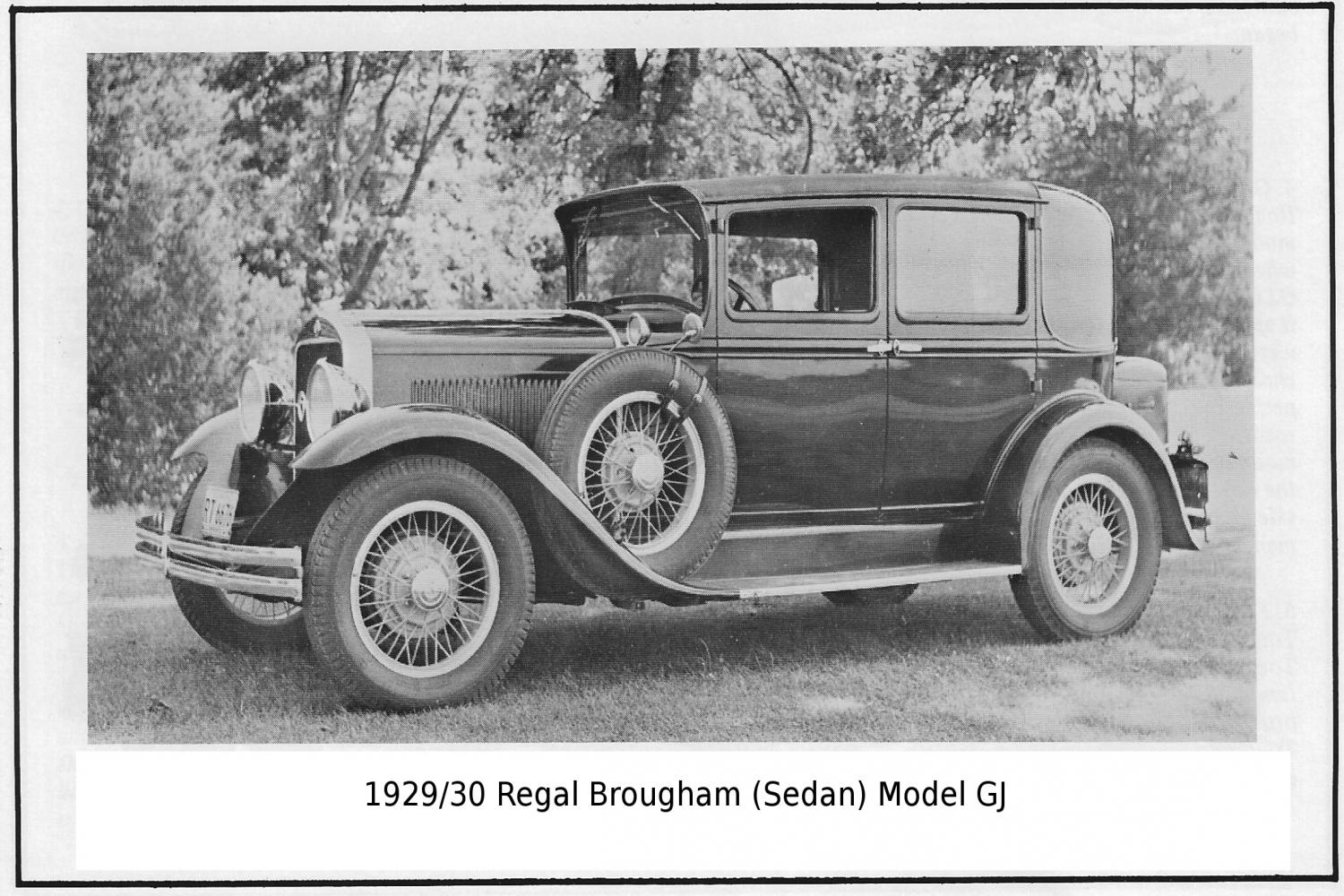 Side
Bar: So whats the difference
between the Brougham's and the Six Window Sedan's. Just one window
each side. The Brougham's only had four side windows. Where the
third and farthest back pair of windows on a sedan were glass the
Brougham's had this same area covered with steel which wrapped around
and meet the back window. The Brougham's which were four-door,
five-passenger cars, are not to be confused with the St. Regis
Brougham's which would come in 1932, as those cars were close-coupled
two-door sedans. Side
Bar: So whats the difference
between the Brougham's and the Six Window Sedan's. Just one window
each side. The Brougham's only had four side windows. Where the
third and farthest back pair of windows on a sedan were glass the
Brougham's had this same area covered with steel which wrapped around
and meet the back window. The Brougham's which were four-door,
five-passenger cars, are not to be confused with the St. Regis
Brougham's which would come in 1932, as those cars were close-coupled
two-door sedans.
Ref:
TW Nov. 2008 Feature Article “Studebaker's 1929-30 GJ & FD
Commander's” by Fred Fox
| When data was available from TW or STCS (Studebaker the Complete Story) it is used. Else, TCCD (The Classic Car Database) & SCAC (The Standard Catalog of American Cars) is used. →Information found between the arrows is from Turning Wheel feature articles written by Fred Fox← What we can be fairly sure of is that the same body styles, depending on the source, were sometimes listed in different terms. SB= South Bend, LA= Los Angles, and CAN= Canada |
| Model |
Doors |
Passenger |
Price |
| 1029/1930 Model FD Commander |
| Regular Sedan 5-Passenger (W1) |
4 |
5 |
$1,525.00 |
| Regal 5-Passenger Sedan (W2) |
4 |
5 |
$1,645.00 |
| Brougham – Mohair (B2), Broadcloth (B4) |
4 |
5 |
$1,675.00 |
| Victoria 4-Passenger (C1) |
2 |
4 |
$1,525.00 |
| Convertible Cabriolet 4-Passenger (E) |
2 |
4 |
$1,645.00 |
| Regal Sport Roadster (R) |
2 |
4 |
$1,595.00 |
| Coupe 2-Passenger (Q1) |
2 |
2 |
$1,495.00 |
| Coupe 4-Passenger (Q3) |
2 |
4 |
$1,550.00 |
| Tourer 5-Passenger (T1) |
4 |
5 |
$1,495.00 |
| Regal Tourer 5-Passenger (T2) |
4 |
5 |
$1,595.00 |
| Tourer 7-Passenger (L1) |
4 |
7 |
$1,545.00 |
| Regal Tourer 7-Passenger (L2) |
4 |
7 |
$1,645.00 |
| Sedan 7-Passenger (X1) |
4 |
7 |
$1,695.00 |
| Regal Sedan 7-Passenger (X2) |
4 |
7 |
$1,845.00 |
| →Production of the FD started sometime in December of 1928 and was released to the public in January of 1929, It most likely ended production in June of 1930 (not confirmed by Fox). Studebaker assigned 24,331 SB serial numbers and 404 CAN serial numbers to the Model FD. Fox listed total production at 24,735 an exact match (likely used the serial numbers to calculate production). Engine Serial Numbers FD-1 to 24,900. For more complete information see TW Nov. 2008← TCCD, SCAC both agree for most part with these model listing. Cannon's article from “The Antique Studebaker Review” called the Roadsters “Sport” Roadsters, where Fox just called them Roadsters. Cannon also mentioned that there may have been a FD Q5 Coupe. Which makes us wonder if that could have been a FD Regal Coupe? |
We
do not have access to any TW articles for the 1931 Commander 70
series and Fox and Cannon did not elaborate much in “Studebaker the
Complete Story”, so this is what little information we could scare
up.
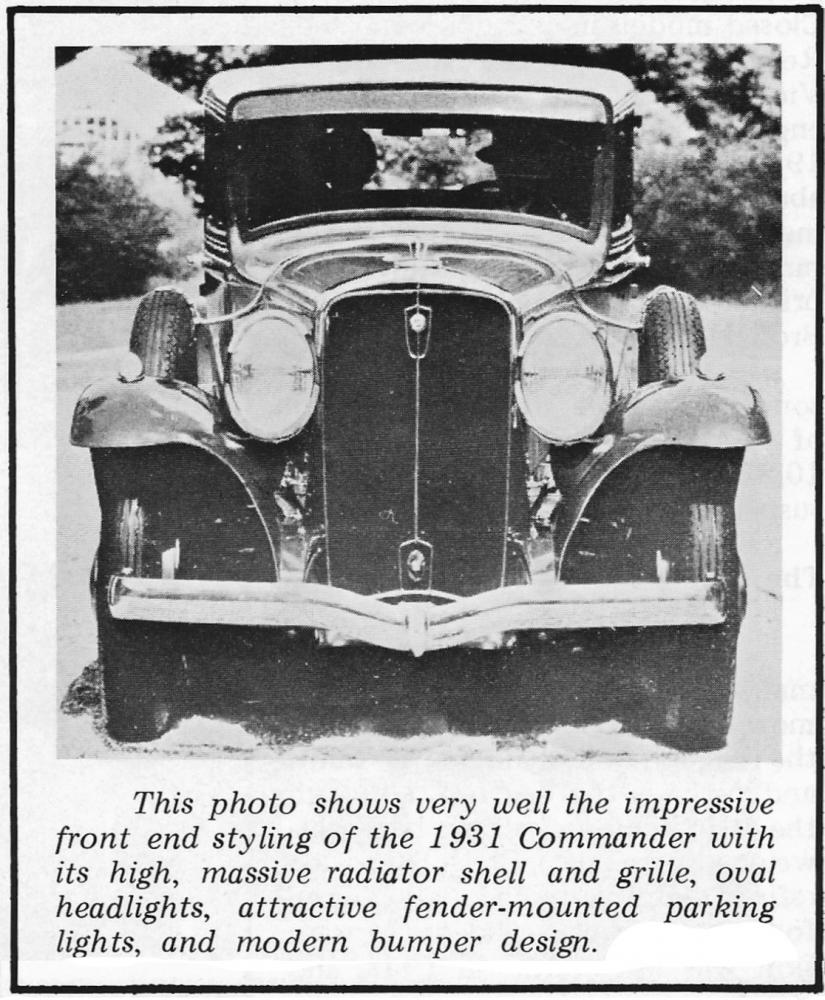 
While
the 1931 Commander was almost a entirely new design, the line-up was
also greatly simplified. The six cylinder models were history, only
an eight being offered. The open cars, convertible, roadster, and
touring were gone. Only the Brougham, Coupe, Victoria, Sedan, and
Regal Sedan were being offered. Most of of it's four inch added
length came in front of the cowl, making the hood extremely long and
very impressive. A new V-shaped prominent grille and large oval
headlights graced the front of the car. The single bar bumper, with
it's V-dip in the center, and fender mounted parking lights were
distinctive features. The polo cap visor reappeared after being
absent on some 29/30 models.
Tell’s
for 1931: A new V-shaped radiator shell,
flanked by large oval
headlights. Parking
lights
were
placed on top of the front fenders. A new single
bar bumper with V-shaped dip
in
the center was used.
Mechanical:
A
new design silent transmission with helical gears and free-wheeling;
larger improved two-shoe Duo-Servo Bendix brakes; new valve spring
dampeners; new carburetor air intake filter and silencer; new
dual-throat carburetor; new dual intake manifold; and improved
torsional vibration dampener were all improved features for 1931. The manifold, carburetor, and compression increase to 5.2 to 1,
increased valve overlap, resulted in the flat-head eight’s HP
increase to 101. The wheelbase is stretched to 124 inches and a kick
shackle is added to reduce shimmy and wheel fight. Tires are 6.00 x 19
and a finer mesh ring and pinion created a quieter rear axle.
| When data was available from TW or STCS (Studebaker the Complete Story) it is used. Else, TCCD (The Classic Car Database) & SCAC (The Standard Catalog of American Cars) is used. →Information found between the arrows is from Turning Wheel feature articles written by Fred Fox← What we can be fairly sure of is that the same body styles, depending on the source, were sometimes listed in different terms. SB= South Bend, LA= Los Angles, and CAN= Canada |
| Model |
Doors |
Passenger |
Price |
| 1931 Model 70 Commander |
| Regular Coupe (Q1) |
2 |
2 |
$1,585.00 |
| Regular Coupe w/rumble seat (Q3) |
2 |
4 |
$1,585.00 |
| Regal Brougham (B2, B4) |
4 |
5 |
$1,685.00 |
| Regal Sedan (W2, W4) |
4 |
5 |
$1,685.00 |
| Sedan (W1, W3) |
4 |
5 |
$1,585.00 |
| Victoria (C1, C2) |
2 |
4 |
$1,585.00 |
| Production began in July of 1930 and continue to September of 1931 (SCAC). According to STCS, the starting SB serial number was 8,025,001 and ended at 8,036,000 (11,000). CAN serial numbers started at 8,950,500 and ended at 8,950,700 (200). TCCD and SCAC both put production at 10,823 units, slightly under the total number of serial numbers assigned (11,200). Engine Numbers started at C-101 and ended at C12,000 (11,900). Some of these engines went into commercial vehicles and bare chassis. Both SCAC & TCCD agreed on the model line-up and pricing. |
 Again,
we do not have access to a TW articles for the 1932 Commander 71
series. Fox and Cannon, in “Studebaker the Complete Story” was
fairly thin. So like 1931, this is what little information we could
scare up. Again,
we do not have access to a TW articles for the 1932 Commander 71
series. Fox and Cannon, in “Studebaker the Complete Story” was
fairly thin. So like 1931, this is what little information we could
scare up.
1932
Commander line-up was expanded. Open cars again appeared;
Convertible Sedan, Regal Convertible Sedan, Roadster, and Regal
Roadster were added . A new St. Regis Brougham and Regal St. Regis
Brougham were also added, as well as a Regal Coupe. The Regal
Brougham and Victoria are gone (see side bar 2 below). Last years
Sedan, Regal Sedan, and Coupe are still in the line-up. Regal
equipment includes six, side mounted, wire or chrome platted
artillery spoke wheels; duel trumpet horns; and a luggage rack. The
package could be applied to any standard model at extra cost. Wire
or steel spoke artillery wheels are also available options. The
instrument panel is redesigned with airplane-type round dials.
Tell’s
for 1932:
It
is difficult to tell the 1932 Studebaker from the 1931, however on
closed cars, the polo
cap is gone
and
all the windshields
began to slope
forward. The gages
on
the dash inside are round
instead
of square. Parking
lights
still placed on top of the front fenders. Regal’s have the new art
deco “Bird”mascot radiator cap, optional on all other models.
Mechanical:
A
new synchromesh transmission is introduced and freewheeling is
removed from the transmission, placed in a separate unit and bolted
on the back of the transmission. Houdaille automatic-ride shock
absorbers replace the Delco-Lovejoy units and Startix automatic
starting systems is a new standard items. A newer style
cable-controlled Bendix braking system was used. The wheelbase
increases to 125 inches.
Side
Bar 1:
The Startix system
was an automatic engine starting mechanism. It automatically started
an engine from cold or restarted the engine if stalled. All you had
to do to activate it, was turn on the key. It was supplied to
vehicle manufacturers in the 1930s
by Bendix Corporation.
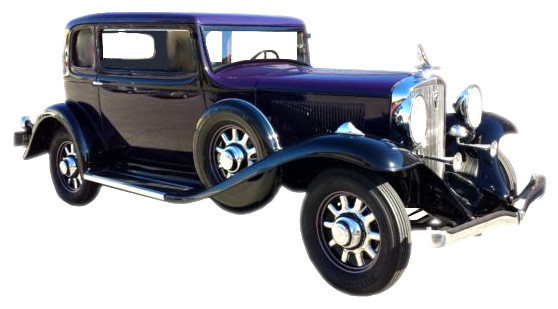 Side
Bar 2:
The St. Regis Brougham (left) , unlike the former Studebaker Brougham, is a
two door close-coupled sedan. For Studebaker, it was said to combine
the luxury features of the former Victoria's with the roominess of a
sedan. Thus, the Victoria's and Brougham's become expendable. This
car has an extremely wide doors (supposedly the longest door
Studebaker ever made) which assisted rear passenger access to the
back seat. Side
Bar 2:
The St. Regis Brougham (left) , unlike the former Studebaker Brougham, is a
two door close-coupled sedan. For Studebaker, it was said to combine
the luxury features of the former Victoria's with the roominess of a
sedan. Thus, the Victoria's and Brougham's become expendable. This
car has an extremely wide doors (supposedly the longest door
Studebaker ever made) which assisted rear passenger access to the
back seat.
| When data was available from TW or STCS (Studebaker the Complete Story) it is used. Else, TCCD (The Classic Car Database) & SCAC (The Standard Catalog of American Cars) is used. →Information found between the arrows is from Turning Wheel feature articles written by Fred Fox← What we can be fairly sure of is that the same body styles, depending on the source, were sometimes listed in different terms. SB= South Bend, LA= Los Angles, and CAN= Canada |
| Model |
Doors |
Passenger |
Price |
| 1932 Model 71 Commander |
| Convertible Roadster (R1) |
2 |
2-4 |
$1,350.00 |
| Regal Convertible Roadster (R2) |
2 |
2-4 |
$1,455.00 |
| Convertible Sedan (S1) |
4 |
5 |
$1,465.00 |
| Regal Convertible Sedan (S2) |
4 |
5 |
$1,570.00 |
| Coupe (Q1) |
2 |
2-4 |
$1,350.00 |
| Regal Coupe (Q4) |
2 |
4 |
$1,455.00 |
| Sedan (W1) |
4 |
5 |
$1,350.00 |
| Regal Sedan(W2) |
4 |
5 |
$1,455.00 |
| St. Regis Brougham (C1) |
2 |
5 |
$1,350.00 |
| Regal St Regis Brougham (C2) |
2 |
5 |
$1,455.00 |
|
|
|
|
| Production began in November of 1931 and continue to November of 1932 (SCAC). According to STCS, the starting SB serial number was 8,036,001 and ended at 8,040,000 (4,000). CAN serial numbers started at 8,950,700 and ended at 8,950,800 (100). TCCD and SCAC both put production at 3,551 units, slightly under the total number of serial numbers assigned (4,100). Engine Numbers started at C-12,001 and ended at C16,100 (4,100). While SCAC and TCCD did agree on the 1932 Model line-up, SCAC priced all the models $95.00 more each except the Coupe's, where they were in agreement. The data shown is from TCCD, |
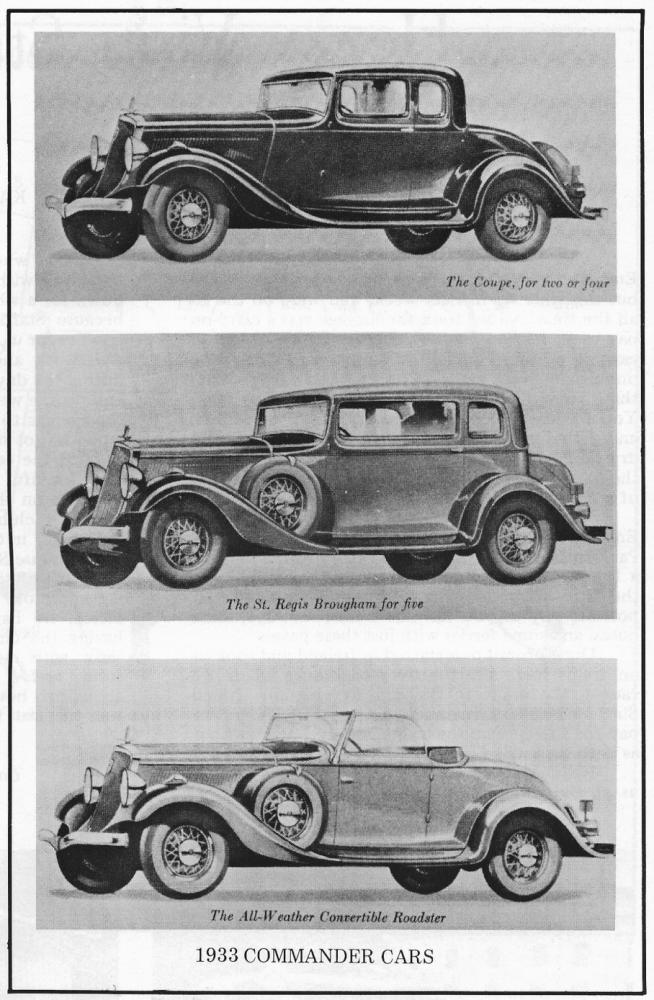 So, what
happened to the “72” commander? Well as is seems, Studebaker was
quite concerned about the 1932 sales results, and according to Fox,
very close the start of 1933 production a major re-alignment of
Studebaker's 1933 models line-up was made. The 56 Six remained the
same, however, the model 63 Dictator replaced the model 72 Commander
and was designated the model 73 Commander. The model 72 Commander
became the model 82 President, and the model 92 President became the
model 92 Speedway President. This move allowed Studebaker to offer
Commander 8's at Dictator prices and the smaller President 8's at
Commander prices. This apparently is a ploy that had been used often
in the automotive industry. So, what
happened to the “72” commander? Well as is seems, Studebaker was
quite concerned about the 1932 sales results, and according to Fox,
very close the start of 1933 production a major re-alignment of
Studebaker's 1933 models line-up was made. The 56 Six remained the
same, however, the model 63 Dictator replaced the model 72 Commander
and was designated the model 73 Commander. The model 72 Commander
became the model 82 President, and the model 92 President became the
model 92 Speedway President. This move allowed Studebaker to offer
Commander 8's at Dictator prices and the smaller President 8's at
Commander prices. This apparently is a ploy that had been used often
in the automotive industry.
The
entire Studebaker line shared the same styling, slightly modified
from 1932, with a more radically forward sloping grille. The front
fenders aprons extend further forward and have
skirts that hide more of the frame and running gear. Roof
lines blend smoothly into concave rear decks. Five painted wire
wheels are standard, chromed wire wheels are optional at extra cost.
Regal's ran standard on plated artillery wheels with 14 spokes. These wheels were were available as extra cost options on regular
models. Another popular option was white wall tires. Upholstery
material was Bedford Cord (standard) on all closed models and
optional on four-door convertible sedans. Mohair was an extra cost
option on all closed models. Leather was standard on Roadsters and
optional on four-door convertible sedans.
Tell’s
for 1933:
The hood
louvers
are now slanted,
in line with the slanted grille. Painted
wire wheels
(Standard, Chrome optional). Fourteen
spoke artillery wheels
(Standard on Regals, optional on Regular models --1932's had ten
spokes). Optional chrome artillery wheels. More slanted grille
and windshield. Front
fenders skirtedfor the first time covering more of the chassis and (if equipped)
side mount cavities. No wood spoke wheels (maybe they could be
special ordered?). Mascot,
still the art deco
bird,
now standard
on all models.
Mechanical: The
model 73 Commander had a slightly larger (one year only) 236 cubic
inch displacement straight eight, making 100 HP and ran on a 8 inch
shorter 117 inch wheel base, formally used on the 1932 Dictator's. The
wheels changed from 18 inches to 17 inches. Down draft carburetors
were used in all Studebaker engines for the first time. Other new
innovations were automatic choke, automatic spark advance, and
automatic manifold heat. New Bendix vacuum-boosted power brakes were
also standard equipment on all Studebaker's. The Startix automatic
starting system was continued from it's 1932 introduction.
However,
all these new features and fanatic styling did little to improve
sales. Studebaker was forced into receivership on March 18th,
1932. But as we all know, would rise from this low point and survive
until 1966. Exterior color offering changed almost monthly according
to Fred Fox. The cars were painted in five different areas, lower
body, upper body, fenders, wheels, and stripes using all kinds of
color combinations.
| When data was available from TW or STCS (Studebaker the Complete Story) it is used. Else, TCCD (The Classic Car Database) & SCAC (The Standard Catalog of American Cars) is used. →Information found between the arrows is from Turning Wheel feature articles written by Fred Fox← What we can be fairly sure of is that the same body styles, depending on the source, were sometimes listed in different terms. SB= South Bend, LA= Los Angles, and CAN= Canada |
| Model |
Doors |
Passenger |
Price |
| 1933 Model 73 Commander |
| Regular 4dr Sedan (W1) |
4 |
5 |
$1,075.00 |
| Regal 4dr Sedan (W2) |
4 |
5 |
$1,180.00 |
| Regular St. Regis Brougham (C1) |
2 |
5 |
$1,075.00 |
| Regal St. Regis Brougham (C2) |
2 |
5 |
$1,180.00 |
| Regular two-passenger coupe (Q1) |
2 |
2 |
$1,000.00 |
| Regal two-passenger coupe (Q2) |
2 |
2 |
$1,105.00 |
| Regular four-pass coupe w/rumble seat (Q3) |
2 |
4 |
$1,050.00 |
| Regal four-pass coupe w/rumble seat (Q4) |
2 |
4 |
$1,155.00 |
| Regular 4dr Convertible Sedan (S1) |
4 |
5 |
$1,195.00 |
| Regal 4dr Convertible Sedan (S2) |
4 |
5 |
$1,300.00 |
| Regular Roadster w/rumble seat (R1) |
2 |
4 |
$1,095.00 |
| Regal Roadster w/rumble seat (R2) |
2 |
4 |
$1,200.00 |
|
|
|
|
|
Front and rear bumpers, although standard, were an extra $25.00. They are not included in the above prices. They were later called a delete option.
|
| Fox did not mention the production start or end dates for the Model 73 Commanders. However, SCAC indicated production started in November of 1932 and ended in July of 1933. →Studebaker assigned 3,781 SB serial numbers and 60 CAN serial numbers to the Model 73. Fox reported SB production at 3,781 and CAN production at 60, most likely calculated from the serial numbers assigned. Engine Serial Numbers are reported at 8,040,001 to 8,043,781 for SB and 8,950,801 to 8,950,860 for CAN. For more complete information see TW Dec. 1991← SCAC and TCCD both reported total 73 Commander production at 3,841 as did Fox. |
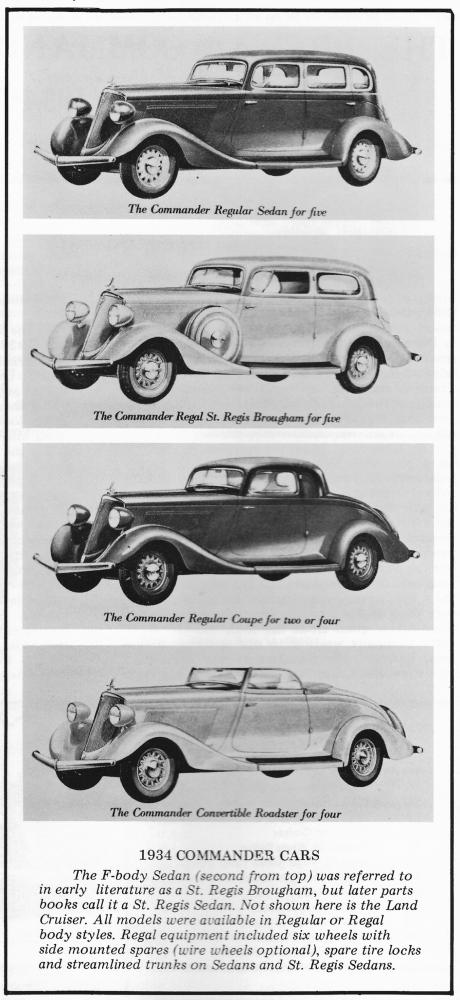 We
were unable to find any TW articles for the 1934 Commander B series. Fox and Cannon did not elaborate much in “Studebaker the Complete
Story”, so this section has to rely on other less reliable sources
once again. We
were unable to find any TW articles for the 1934 Commander B series. Fox and Cannon did not elaborate much in “Studebaker the Complete
Story”, so this section has to rely on other less reliable sources
once again.
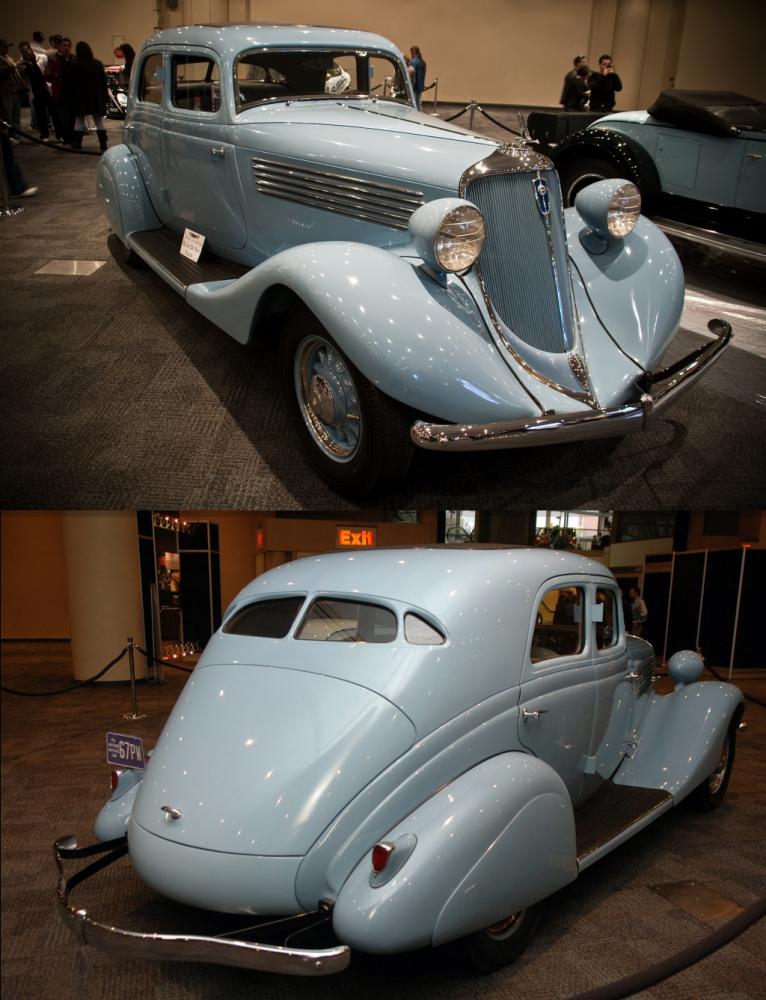
The
entire line of Studebaker cars are redesigned for 1934, however the
actual difference is more subtle then one might think. The general
body lines and contours are altered, becoming more aerodynamic. Thus
the sales pitch for 1934 “From the Skyway Comes Their Style”. The old box design is gone forever. The headlights are now round
bullet-shaped pods, mounted on the fenders near where the parking
lights had been since 1931. The bumpers are now two straight single
bar units, mounted in a V pattern, the V-shaped dip in the center is
gone. The belt line which had been so prominent in past years is
nearly invisible, simply embossed into the body lines, dropping
sharply down near the rear of the cars. From all the photo's we
looked at, it appears that the front doors are now hinged at the back
and open from the front, while the rear doors are hinged in the front
and open from the back. The hood louvers are even more slanted, with
an embossed line around them. The grille is deeper and more slanted. The front fender aprons and the grille panel are significantly
extended out the front of the cars. New tail lights are built into
the rear fenders. Windwings on the front of closed cars roll up and
down. The third window on sedans open, pivoting in the middle. The
interiors are exceptional, with very fine appointments. The fabric
is broadcloth or mohair, the dash panel and steering wheel are new. The Convertible Sedan's were eliminated this year.
However, there is
some evidence that Studebaker did a “Year Ahead” style change in
June of 1934 for Regal's and Custom, where the major influenced was a
move from vertical to horizontal hood louvers. Also, at about this
same time the new and sensational (Right Above Photo) Land Cruiser in DeLuxe and Regal
trim is introduced.
Tell’s
for 1934:
Thehood
louvers
are more slanted and have an embossed
line
around them. Headlights
round bullet-shaped. Straight single
barbumper. Belt
line
nearly invisible. Front door (Suicide). Tail
lights
are integral
to the rear fenders. Mascot,
still the art deco
bird,
standard
on all models.
Mechanical:
The
model B Commander chassis
is new, running on a 119 inch wheelbase. The engine for the Model B
Commander is the same as the earlier Dictator eight with 221 cubic
inch displacement. However a higher compression ratio of 6.3 to 1 and
an aluminum cylinder head, boosted the horsepower to 103. Vacuum
powered Bendix
brakes
were continued. An innovation was the triple beam headlamps. A
control on the instrument panel allowed the driver to select one of
three high beams.
Side
Bar:
On March 18, 1933 Studebaker was forced into receivership. Vance
and Hoffman of Studebaker and Bean of White Motors are appointed
receivers. By the extraordinary efforts of Vance and Hoffman,
Studebaker was out of receivership on March 9th,
1935. This action is to complicated to cover here. It is mentioned
here, because through Vance and Hoffman's effort, the Federal Court
approved an expenditure of $700,000 to retool a completely new line
cars for 1934.
| When data was available from TW or STCS (Studebaker the Complete Story) it is used. Else, TCCD (The Classic Car Database) & SCAC (The Standard Catalog of American Cars) is used. →Information found between the arrows is from Turning Wheel feature articles written by Fred Fox← What we can be fairly sure of is that the same body styles, depending on the source, were sometimes listed in different terms. SB= South Bend, LA= Los Angles, and CAN= Canada |
| Model |
Doors |
Passenger |
Price |
| 1934 Model B Commander |
| St. Regis Brougham (C1) |
2 |
5 |
$915.00 |
| Regal St. Regis Brougham (C2) |
2 |
5 |
$965.00 |
| Regular two-passenger coupe (Q1) |
2 |
2 |
$895.00 |
| Regal two-passenger coupe (Q2) |
2 |
2 |
$925.00 |
| Regular four-pass coupe w/rumble seat (Q3) |
2 |
4 |
$945.00 |
| Regal four-pass coupe w/rumble seat (Q4) |
2 |
4 |
$975.00 |
| Regular Roadster w/rumble seat (R1) |
2 |
4 |
$945.00 |
| Regal Roadster w/rumble seat (R2) |
2 |
4 |
$975.00 |
| Regular 4dr Sedan (W1) |
4 |
5 |
$945.00 |
| Regal 4dr Sedan (W2) |
4 |
5 |
$995.00 |
| DeLuxe Land Cruiser (L3) * |
4 |
5 |
$1,135.00 * |
| Regal Land Cruiser (L2) * |
4 |
5 |
$1,135.00 * |
| Production starts in September of 1933 and ends in October of 1934 (SACA). According to STCS, the starting SB serial number was 8,045,001 - up. CAN serial numbers started at 8,951,001 to 8,951,200 (200) . Engine Numbers started at C-20,001 – up. The next series of Commander serial numbers, assigned to 1935 Commander 1B starts at 8,103,000. So we clearly do not know the ending serial number for 1934 SB production. TCCD and SCAC both put production at 10,315 units and both list the same models, except for the DeLuxe Land Cruiser, which only Fox listed (See next section). * →In the TW Article “Studebaker's 1934 – 1954 Land Cruiser Models” by Fred Fox, it is stated that both the DeLuxe and Regal (L3 & L2) were produced in the spring or summer of 1934. However, only one price was given. Production of the 1934 Land Cruiser was 203 units. The difference between DeLuxe and Regal Land Cruiser was DeLuxe had a single spare in the trunk and Regal had dual sidemounts.← |
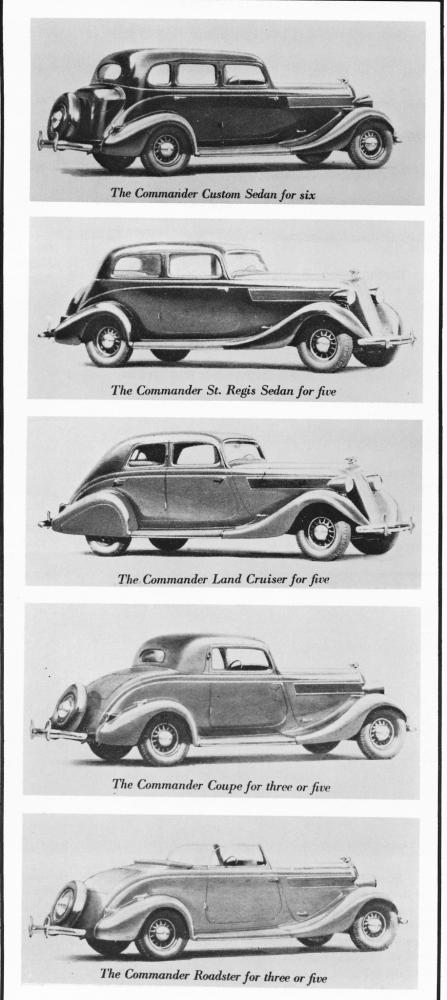 The
1935 Commander was just face lifted from 1934. The headlights are
still round but much longer then they were in 1934. The bumpers are
single piece, rounded rather then slanted design. The center
vertical bar grille is way narrow, two shorter horizontal bar side
grille are placed next to the main grille. The hood louvers are
horizontal bar and match the side grilles. A new encircled bird
mascot is standard on Commander's. The interiors are even more
luxurious then the 34's. The model line-up is the same as 1934. The
1935 Commander was just face lifted from 1934. The headlights are
still round but much longer then they were in 1934. The bumpers are
single piece, rounded rather then slanted design. The center
vertical bar grille is way narrow, two shorter horizontal bar side
grille are placed next to the main grille. The hood louvers are
horizontal bar and match the side grilles. A new encircled bird
mascot is standard on Commander's. The interiors are even more
luxurious then the 34's. The model line-up is the same as 1934.
Tell’s
for 1935:
Thehood
louvers
are horizontal
and flow into the side grilles. The grille
is much narrower. Headlights
round, but longer. Single
piece rounded
shaped bumper. Mascot,
new encircled
bird,
standard on Commander's and Dictator's.
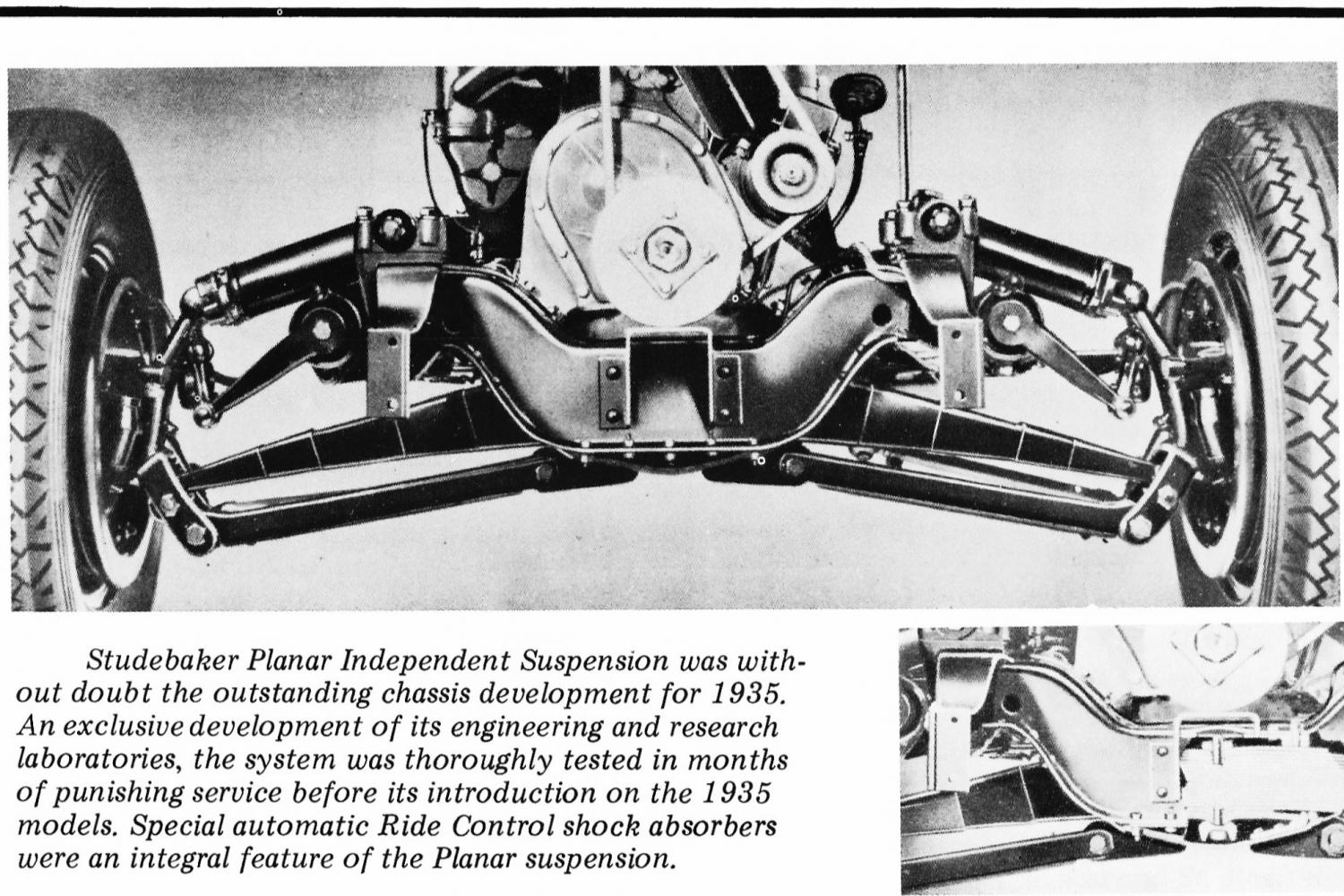 Mechanical:
The
model B1 Commander has a new independent front suspension system
called “Planar” by Studebaker. The
engine for the Model B1 Commander is the same 250 cubic inch
displacement engine used in the President, but with a 6.0 to 1
compression ratio cast iron head, making 107 HP. Four wheel
hydraulic brakes are used for the first time. The 1935 Commander would be
the last Eight, as the Commander line will be dropped for 1936 and 1937. It would return in 1938 as a replacement of the 1937 Dictator, as a Commander Six. Mechanical:
The
model B1 Commander has a new independent front suspension system
called “Planar” by Studebaker. The
engine for the Model B1 Commander is the same 250 cubic inch
displacement engine used in the President, but with a 6.0 to 1
compression ratio cast iron head, making 107 HP. Four wheel
hydraulic brakes are used for the first time. The 1935 Commander would be
the last Eight, as the Commander line will be dropped for 1936 and 1937. It would return in 1938 as a replacement of the 1937 Dictator, as a Commander Six.
| When data was available from TW or STCS (Studebaker the Complete Story) it is used. Else, TCCD (The Classic Car Database) & SCAC (The Standard Catalog of American Cars) is used. →Information found between the arrows is from Turning Wheel feature articles written by Fred Fox← What we can be fairly sure of is that the same body styles, depending on the source, were sometimes listed in different terms. SB= South Bend, LA= Los Angles, and CAN= Canada |
| Model |
Doors |
Passenger |
Price |
| 1935 Model B1 Commander |
| St. Regis Brougham (C1) |
2 |
5 |
$955.00 |
| Regal St. Regis Brougham (C2) |
2 |
5 |
$970.00 |
| Regular two-passenger coupe (Q1) |
2 |
2 |
$895.00 |
| Regal two-passenger coupe (Q2) |
2 |
2 |
$930.00 |
| Regular four-pass coupe w/rumble seat (Q3) |
2 |
4 |
$950.00 |
| Regal four-pass coupe w/rumble seat (Q4) |
2 |
4 |
$980.00 |
| Regular Roadster w/rumble seat (R1) |
2 |
4 |
$950.00 |
| Regal Roadster w/rumble seat (R2) |
2 |
4 |
$980.00 |
| Regular 4dr Sedan (W1) |
4 |
5 |
$985.00 |
| Regal 4dr Sedan (W2) |
4 |
5 |
$1,000.00 |
| Land Cruiser (L3 *) |
4 |
5 |
$1,115.00 * |
| Regal Land Cruiser (L2) * |
4 |
5 |
$1,130.00 * |
| Limousine Cabriolet ** |
4 |
6 |
$1,185.00 |
| SCAC and TCCD put production at 6,085 units. The data in the chart is from TCCD unless otherwise specified. SCAC listed production from November of 1934 to September of 1935. SCAC listed mostly the same models, but their price was exactly $30 more for model, and they did not list a **Limousine Cabriolet, but did list the Land Cruiser (L3) not listed by TCCD. *→The (L3) & (L2) price comes from the TW Article “Studebaker's 1934 – 1954 Land Cruiser” by Fred Fox.← SCAC listed the Land Cruisers at the same price as Fox. TCCD listed the (L2) at $1,100 and did not even list the (L3). STCS lists the starting Serial Number at 8,951,201 – up for SB and 8,951,201 – up for CAN. Engine numbers started at C-30,501 – up. As 1935 would be the last year for the Commander 8's, it is impossible to know the ending serial numbers by looking at the next year serial numbers. |
 Again,
we do not have access to a TW articles for the 1938 Commander 7A &
8A series. So the information here is only what we were able to
glean from the Internet and other less reliable sources. Again,
we do not have access to a TW articles for the 1938 Commander 7A &
8A series. So the information here is only what we were able to
glean from the Internet and other less reliable sources.
We
however do know that 1938 is an entirely new design, done for the
first time by Lowey and Associates, they are now Studebaker's design
department and would remain so through 1956. The interiors design
was influenced by Helen Dryden, the seats are a full five inches
wider. Broadcloth was standard, but mohair velvet and colored
leather were optional. The door handles and window cranks are newly
designed and very elegant.
The
Commander is replacing the Dictator, who's name has fallen out of
favor. Studebaker starts the production year with the “Studebaker
Six 7A” and the “Commander 8A”. Early in 1937 Studebaker
changed the name of “Studebaker Six 7A” to “Commander 7A” and
the “Commander 8A” became the “State Commander 8A”. This
change over was announced by Studebaker in a letter to it's dealers
dated December 3rd,
1937 (STCS). There were no actual changes to either of the series. So, what is the difference between a Commander and a State Commander? There are few, but the most noticeable is that Commanders have
bullet style headlights, mounted on the catwalks and State Commanders
have the President style (Cathedral) faired in headlights, which
makes each series easy to identify. Other equipment standard on
State Commanders and optional on Commanders was deluxe steering
wheel, twin horns, and Hill-Holder. State Commanders also have
better appointments in the interior.
Tell’s
for 1938:
The
new design for this year is much smoother,
much lower,
and six inches wider. The hood
louvers are eliminated
and the cars are nearly void of trim. A simple chrome bead molding
stretches from the grille to the rear deck. Series 7A
have bullet-shaped headlights
mounted on the catwalks and 8A
series have Cathedral headlights. A
newinstrument panel
has square
gauge
clusters. The grille
seems taller and narrower. It has five
distinct sections,
separated by wider horizontal bands. The vertical
center bar
from last year is gone.
Mechanical:
The
engine, used on both series, formally used on the Dictator, is bored
out 1/16th
of an inch to 226.2 cubic inches, but makes the same 90 HP. The the
engine and seats are moved forward, the distance varies from 3 ½ to
5 ½ depending on which source you believe. The front seat is at
least five inches wider, Studebaker claimed six. The tunnel is
nearly eliminated by turning the transmission on it's side. The
wheel base is 116 ½ inches, ½ inch longer then the 1937 Dictator it
replaced. Planer suspension, safety glass, dual tail lights, dual
wipers and divided windshields are standard equipment. Also
included at regular price was a speedometer, engine thermometer,
Autolite ignition, Borg clock, Casco cigar lighter, two-way Houdaille
shock absorbers, spring covers and Bud steel disc wheels.
Optional
Equipment:
Most of the options are not mentioned. However, two items which
seemed to get a lot of play are the free-wheeling overdrive
transmission and the the vacuum actuated Evans “Miracle Shift.” The control for this unit was mounted in the center of the lower part
of the dash, which left the floor clear for easier seating of three
front seat passengers. It operated on the standard “H” shift
pattern. It was often troublesome and when “three on the tree”
came out in 1939, became obsolete.
| When data was available from TW or STCS (Studebaker the Complete Story) it is used. Else, TCCD (The Classic Car Database) & SCAC (The Standard Catalog of American Cars) is used. →Information found between the arrows is from Turning Wheel feature articles written by Fred Fox← What we can be fairly sure of is that the same body styles, depending on the source, were sometimes listed in different terms. SB= South Bend, LA= Los Angles, and CAN= Canada |
| Model |
Doors |
Passenger |
Price |
| 1938 Model 7A Commander |
| Business Coupe |
2 |
3 |
$875.00 |
| Custom Coupe |
2 |
5 |
$900.00 |
| Club Sedan |
2 |
5 |
$995.00 |
| Cruising Sedan |
4 |
6 |
$965.00 |
| Convertible Sedan |
4 |
6 |
$1,315.00 |
| SCAC indicated the production started September of 1937 and ended July of 1938, they put production at 19,260 units. TCCD listed models and prices exactly the same as SCAC for 7A models, but under “Six Series” with no production data. They then listed the same 7A production number as SCAC did, under the caption “Commander Series 7A” with “price and model” information which matched SCAC's 8A information. Then under “Commander Series 8A” no data is available for “model, price or production”. STCS lists the starting Serial Number at 5,582,001 for SB and 5,857,501 for LA. Engine numbers started at H-101, 1939 Commander engines start at H42,501, so we know that 42, 400 1938 engine number were assigned. |
| Model |
Doors |
Passenger |
Price |
| 1938 Model 8A Commander |
| State Custom Coupe |
2 |
5 |
$995.00 |
| State Club Sedan |
2 |
0 |
$1,030.00 |
| State Cruising Sedan |
4 |
6 |
$1,040.00 |
| State Convertible Sedan |
4 |
6 |
$1,365.00 |
| SCAC indicated the production started August of 1937 and ended July of 1938, they put production at 22,053 units. TCCD has no data, in the “Commander Series 8A” link. However, under “Commander Series 7A”, they listed production that agreed with SCAC for 7A, but listed “model and price” information that agreed with SCAC's 8A information (exception TCCD listed the Convertible Sedan at $1,390). The information on TCCD is clearly confusion created by Studebaker changing the “Six 7A “ to “Commander 7A” and “Commander 8A” to “State Commander 8A”. STCS lists the starting 8A serial number at 4,090,001 for SB and 4,800,001 for LA. The 1939 9A serial numbers start at 4,110,001 for SB and 4,802,301 for LA, that would appear then that 20,000 SB and 2,300 LA serial numbers were assigned to 1938 8A production. (See 7A Chart above for engine serial number information). |
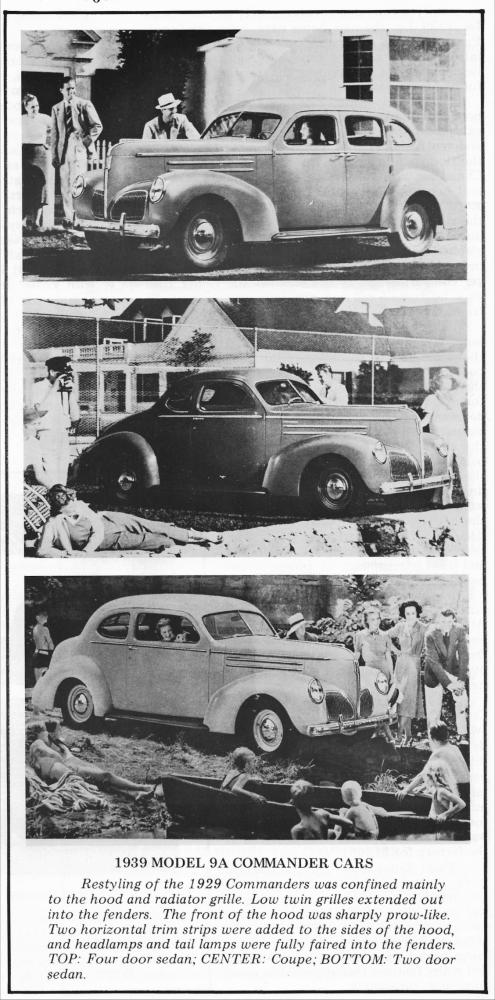 With
1938 being a new design, the 1939 Commander is simply a face lift
from the cowl forward, but the change to the grille is different then
anything we have seen before. The tall vertical grille from the past
is gone. It is replaced by two separate grilles on either side of the
now bare nose, inserted into the front fenders just inside the new
headlights which are completely faired into the fenders. The grille
section are roughly one half as high and twice as wide, covering two
thirds of the front of the car. This shorter wider grille pattern
would remain with Studebaker until the end. We also see new tail
lights built into the rear fenders. The new headlights are slightly
oval and not as yet seal beams, although after 1940 there would be a
kit available to change the 39 headlights to sealed beams. Another
distinction of 1939 Commander's is the two chrome trim strips on the
side panels, below the hood and just below the belt line trim that
extends from near the front of the hood to near the back of the car.
Note, that the 1940 Commander would have only one strip, while the
1938 had none. With
1938 being a new design, the 1939 Commander is simply a face lift
from the cowl forward, but the change to the grille is different then
anything we have seen before. The tall vertical grille from the past
is gone. It is replaced by two separate grilles on either side of the
now bare nose, inserted into the front fenders just inside the new
headlights which are completely faired into the fenders. The grille
section are roughly one half as high and twice as wide, covering two
thirds of the front of the car. This shorter wider grille pattern
would remain with Studebaker until the end. We also see new tail
lights built into the rear fenders. The new headlights are slightly
oval and not as yet seal beams, although after 1940 there would be a
kit available to change the 39 headlights to sealed beams. Another
distinction of 1939 Commander's is the two chrome trim strips on the
side panels, below the hood and just below the belt line trim that
extends from near the front of the hood to near the back of the car.
Note, that the 1940 Commander would have only one strip, while the
1938 had none.
The
interior has a new instrument panel and the panel and window moldings
are painted in a wood burl pattern. The interior hardware was
finished in plastic, harmonizing with the interior color. This was
an extension of the Lucite speedometer and clock facings used in 1938
Commander's.
Tell’s
for 1939:
Newtaillights
built into the rear-fender. New ovalheadlights
faired into the front fenders. New lower,
wider grille.
Two
chrome strips
under the hood.
Mechanical:
The
first for Studebaker, steering column three-speed gear shift lever,
seen on some GM cars in 1938, it is adopted by nearly all American
manufactures this year. Die-hards, at least early in the year could
order cars with floor shift. The overdrive transmission is modified
with a switch under the accelerator petal. When pushed all the way
to the floor, is allowed you to move out of overdrive without slowing
down. When the switch is made, a solenoid shuts off the engine for
1/5 of a second,relieving the torque on the transmission, which
allowed the overdrive pawl to disengage the sun gear. This is a big
advancement over earlier systems. Also, the overdrive cut-in speed
is reduced from 40 to 30 mph. All Studebaker overdrive systems would
remain this way until the end of production. Note: overdrives were
first introduced in 1935 Presidents. 1939 would also see the
introduction of the famous Studebaker Climatizer heating and
ventilating system. To began with the unit was under the drivers
side seat, later it would move the under the passenger side seat. While the name would continue to the end of production, the last year
it was placed under the passenger side seat would be 1959 for sedans
and 1963 for Hawks. The wheel base remains at 116 ½ inches.
| When data was available from TW or STCS (Studebaker the Complete Story) it is used. Else, TCCD (The Classic Car Database) & SCAC (The Standard Catalog of American Cars) is used. →Information found between the arrows is from Turning Wheel feature articles written by Fred Fox← What we can be fairly sure of is that the same body styles, depending on the source, were sometimes listed in different terms. SB= South Bend, LA= Los Angles, and CAN= Canada |
| Model |
Doors |
Passenger |
Price |
| 1939 Model 9A Commander |
| Four-door Cruising Sedan w/ trunk spare (W3) |
4 |
5 |
$965.00 |
| Two-door Club Sedan w/ trunk spare (F3) |
2 |
6 |
$955.00 |
| Four-door Convertible Sedan w/ trunk spare (S3) |
4 |
6 |
$1,290.00 |
| Three Passenger Custom Coupe w/ interior spare (Q1) |
2 |
3 |
$900.00 |
| Three Passenger Business Coupe w/ interior spare (Q1) |
2 |
3 |
$875.00 |
| Four-door Station Wagon * |
4 |
? |
? |
Studebaker parts books listed a (W7), (F7), and (Q7) Deluxe Models. What constitutes “Deluxe” is not well defined. 1939 price lists show a “Deluxe Equipment Package” at an additional $30.00. This package included a Phantom Steering Wheel, Horn Ring, Electric Clock, Cigar Lighter, and extra Horn.
|
| Fox indicated that production started in August of 1938 and ended August of 1939 for Commanders. SCAC indicated production started in September of 1938 and ended in August of 1939. →Studebaker assigned 38,500 SB serial numbers and 5,300 LA serial numbers to the Model 9A. Fox reported two sources for 1939 production, the first reports 43,724 for SB and LA combined, the second lists SB at 38,493 and LA at 5,260, 29 more units. The second sources may have included bare chassis sales. Engine Serial Numbers are reported at H-42,501 to H-87,600. For more complete information see TW Oct. 1990← * SCAC listed a Station Wagon (No Price), TCCD did not list the Convertible Sedan or the Station Wagon. They both reported total Commander production at 43,724 as did Fox in source one. |
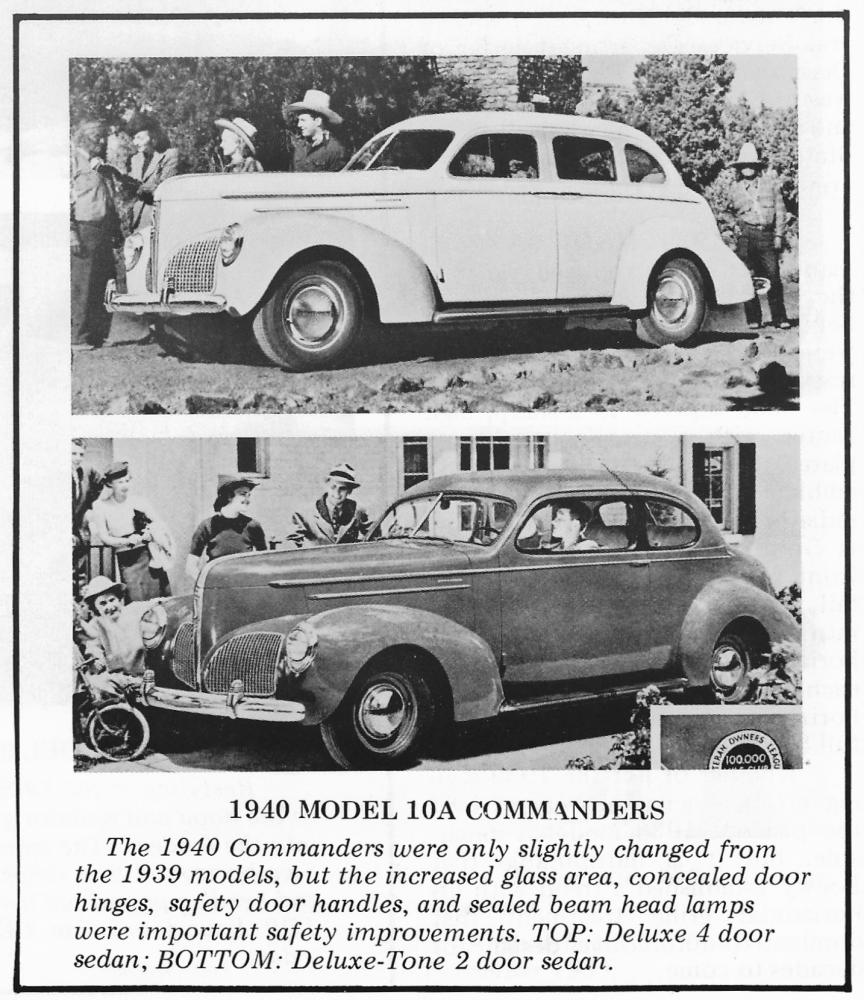 Often
the 1940 Commander's are seen as, just a 1939 with Seal Beam
headlights. Actually Studebaker has quite a few changes for 1940 as
listed below: Often
the 1940 Commander's are seen as, just a 1939 with Seal Beam
headlights. Actually Studebaker has quite a few changes for 1940 as
listed below:
-
New
headlights (sealed Beam design).
-
Total
glass was increased by 241 square inches, including the windshields.
-
Rear
quarter windows, slide instead of swinging out.
-
Door
hinges, except the front lower ones are hidden.
-
New
gas tank filler door, hides the gas cap and filler tube.
-
Safety
glass in all windows.
-
Inside
hood release.
-
Rear
seating room expanded.
-
Door
handles faired into the side trim.
-
Grille
changed from vertical bars to mesh.
-
New
brushed stainless panels for interior door handles and window
regulators, and recessed portions of the instrument panel.
-
Wider
rear tread.
-
6.25
x 16 tires.
-
New
shockless steering. Longer steering Knuckle arms.
-
Rubber
mounted rear spring shackles.
-
New
transmission design (on the side 1938-39 discontinued).
Models
for 1940 Commander's are, four-door Cruising Sedan, two-door Club
Sedan, and a Coupe in Regular and DeLuxe trim. DeLuxe models had
upgraded trim and extra items like duel horns. Regular Commander's
came with wool cloth upholstery. Leather upholstery was an extra
cost option offered in several colors. Many of the Commander paint
colors came with a complementary accent color around the side
windows.
However,
the big news for 1940 was Studebaker's April 1940 release of an all
new trim series called the Delux-tone. These models featured
colorful two-tone interiors, standard whitewall tires, Burnt Orange
or Maroon wheels, deluxe steering wheels, tenite gear shift knobs,
and five different two-tone exterior paint combinations or four solid
colors, all for $40 dollars more then regulator models. The
two-toned upholstery used in these models was either two colors of
broadcloth or on green models, light green broadcloth and dark green
leather. The following is a listing of colors available on
Commander's and Presidents.
|
Regular Models
Exterior Colors |
|
Body Color |
Window Reveal
Accent Color |
|
Colleen Green Light
Metallic |
Colleen Green Dark
Metallic |
|
Birchleaf Light
Metallic |
Birchleaf Dark
Metallic |
|
Clipper Grey Light
Metallic |
Clipper Grey Dark
Metallic |
|
Santa Anita Beigh
Light Metallic |
Santa Anita Beigh
Dark Metallic |
|
Riviera Blue Metallic |
Riviera Blue Grey
Metallic |
|
Riviera Blue Metallic |
Riviera Blue Metallic |
|
Velvet Black |
Velvet Black |
|
California Grapetone
Maroon |
California Grapetone
Maroon |
|
Beverly Blue (1) |
Beverly Blue |
|
Studebaker Cream (2) |
Studebaker Cream |
|
Delux-Tone
Models Exterior Colors |
|
Lower Color |
Upper Color |
|
Riviera Blue Metallic
(M) |
Riviera Blue Grey
Metallic |
|
Clipper Grey Dark
Metallic (O) |
Clipper Grey Light
Metallic |
|
Paddock Green Dark
(M) |
Paddock Green Light |
|
Birchleaf Dark
Metallic (O) |
Birchleaf Light
Metallic |
|
Santa Anita Beigh
Dark Metallic (O) |
Santa Anita Beigh
Light Metallic |
|
Velvet Black |
Velvet Black |
|
Tulip Cream |
Tulip Cream |
|
California Grapetone
Maroon |
California Grapetone
Maroon |
|
Ruby Red |
Ruby Red |
|
(1) Not available
LA Plant, (2) Only available LA Plant, (M) Maroon wheels, (O)
Burnt Orange wheels. Painted with 12 coats of lacquer. |
|
Upholstery
Materials |
|
Regular
Models, wool cloth, optional extra cost colored leather. |
|
Delux-Tone |
|
Blue
& Grey broadcloth |
Riviera
Blue, Clipper Grey, and Velvet Black |
|
Light
Green broadcloth & dark Green Leather |
Paddock
Green, Birchleaf |
|
Brown
& beige broadcloth |
Santa
Anita Beige, Tulip Cream, California Grapetone Maroon, Ruby Red |
|
Seat
upholstery was pleated on Delux-tone Commander's |
Tell’s
for 1940:
Seal beam headlights. New meshgrille.
A single chrome
strip
under the hood. Concealedhinges on all doors.
Mechanical:
The Commander's continue with the 90 HP 116.2 cubic inches Six. Wheel base is 116 ½ inches. Hill-Holder is standard equipment.
| When data was available from TW or STCS (Studebaker the Complete Story) it is used. Else, TCCD (The Classic Car Database) & SCAC (The Standard Catalog of American Cars) is used. →Information found between the arrows is from Turning Wheel feature articles written by Fred Fox← What we can be fairly sure of is that the same body styles, depending on the source, were sometimes listed in different terms. SB= South Bend, LA= Los Angles, and CAN= Canada |
| Model |
Doors |
Passenger |
Price |
| 1940 Model 10A Commander |
| Regular four-door Cruising Sedan (W3) |
4 |
6 |
$965.00 |
| Delux-tone four-door Cruising Sedan (W5) |
4 |
6 |
$1,005.00 |
| DeLuxe four-door Cruising Sedan (W7) +++ |
4 |
6 |
$965.00 |
| Regular four-door Club Sedan (F3) |
2 |
6 |
$925.00 |
| Delux-tone four-door Club Sedan (F5) |
2 |
6 |
$965.00 |
| DeLuxe four-door Club Sedan (F7) +++ |
2 |
6 |
$925.00 |
| Regular Coupe (Q1) |
2 |
3 |
$895.00 |
| Delux-tone Coupe (Q5) |
2 |
3 |
$935.00 |
| DeLuxe Coupe (Q7) +++ |
2 |
3 |
$895.00 |
| +++ The DeLuxe line was actually the Regular line with DeLuxe trim and equipment. There was most likely no standard pricing, so the $965, $925, & $895 numbers are just the base price. |
| Fox did not mention the production start or end dates for the 10A Commander. However, SCAC indicated production started in September of 1939 and ended in June of 1940. →Studebaker assigned 33,300 SB serial numbers and 4,300 LA serial numbers to the Model 10A. Fox reported actual production at 33,247 for SB and 4,255 for LA, close to the number of serial numbers assigned. Engine Serial Numbers are reported at H-87,601 to H-122,200. For more complete information see TW Aug. 1987← Neither TCCD, SCAC mention the DeLuxe models, but do recognize all three body styles in the Regular and Delux-tone lines. They both reported total Commander production at 34,477 as Fox mentioned as “Another Source”. |
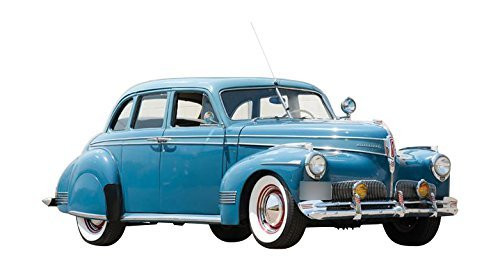 All
the Studebaker lines came with the new twin belt moldings, unique to
all early 1941 Studebaker's (Left Photo, 1941 Commander 4dr Cruising Sedan). Only the later Commander and President
Skyway (Right Photo below) would not have this bright-work. The bodies for all the
Studebaker lines were new for 1941, sharing tail light design,
headlight rings, and a new dash design. Styled by Raymond Loewy’s
associates, they were longer and lower, and had a wider grille. Presidents and Commanders has a new semi-circle bump in the rear
fenders. Running boards were eliminated. All
the Studebaker lines came with the new twin belt moldings, unique to
all early 1941 Studebaker's (Left Photo, 1941 Commander 4dr Cruising Sedan). Only the later Commander and President
Skyway (Right Photo below) would not have this bright-work. The bodies for all the
Studebaker lines were new for 1941, sharing tail light design,
headlight rings, and a new dash design. Styled by Raymond Loewy’s
associates, they were longer and lower, and had a wider grille. Presidents and Commanders has a new semi-circle bump in the rear
fenders. Running boards were eliminated.
Initially, in the senior series,
neither a Coupe or Club Sedan were offered. The Commander 11A came
only in two 4-door body styles, the Cruising Sedan and the Land
Cruiser. The Cruising Sedan had rear-hinged “suicide” rear
doors, with the rear vent windows in the body. The Land Cruiser had
front hinged rear doors with the vent windows in the rear door. Land
Cruisers also had special front and rear fender trim strips, more
bright trim around the window, and a rear seat folding center arm
rest. The Cruising Sedan did not have these features. Early
Commanders came in two trim levels, Custom and Deluxe-tone. The
Custom 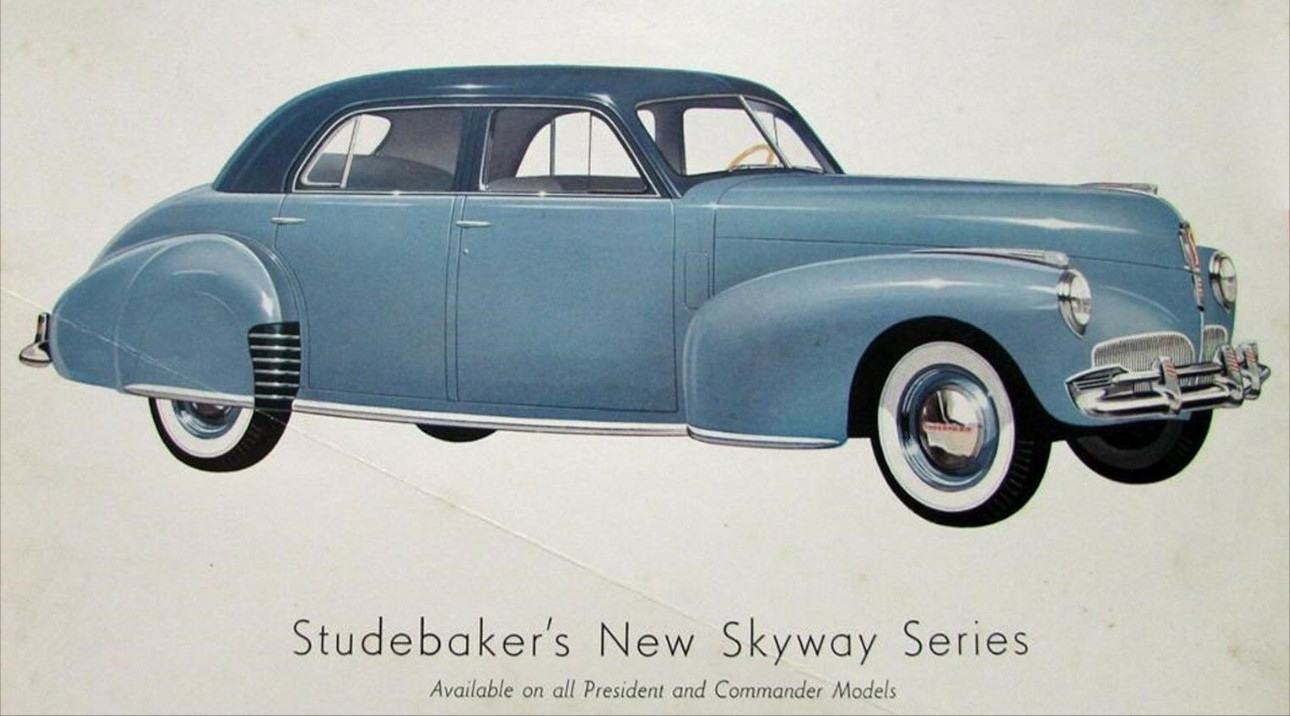 trim was the basic trim, the Deluxe-tone trim option included
two tone paint with color-keyed interiors, standard white wall tires,
DeLuxe steering wheel, and more interior bright-work. The Deluxe-tone
trim option was first introduced in mid 1940. The accent color on 41
Deluxe-tone model two-tones was on the top and between the belt
moldings. The ladder was called a “color belt.” A contrasting
color belt on Custom models was available for an extra $5. This year
the air intake, for the optional Climatizer was moved to a vent door
on the left side of the cowl. A matching fresh air vent door was
added on the right side. In 1947 the purpose of the two vent doors
were switched. These vent doors were used on all Studebaker cars to
1957 and on Hawks to 1964. Also new for 1941 was a separate heater
core for the Climatizer windshield defroster system. trim was the basic trim, the Deluxe-tone trim option included
two tone paint with color-keyed interiors, standard white wall tires,
DeLuxe steering wheel, and more interior bright-work. The Deluxe-tone
trim option was first introduced in mid 1940. The accent color on 41
Deluxe-tone model two-tones was on the top and between the belt
moldings. The ladder was called a “color belt.” A contrasting
color belt on Custom models was available for an extra $5. This year
the air intake, for the optional Climatizer was moved to a vent door
on the left side of the cowl. A matching fresh air vent door was
added on the right side. In 1947 the purpose of the two vent doors
were switched. These vent doors were used on all Studebaker cars to
1957 and on Hawks to 1964. Also new for 1941 was a separate heater
core for the Climatizer windshield defroster system.
In
the spring of 1941 Studebaker introduced a new trim series called the
Skyway. The exterior Skyway trim is considerably different then
Custom and Delux-tone models. Obvious difference was the lack of the
dual side moldings. Other features included, rear fender skirts,
front fender top lamps, bright metal trim around the windows, trimmed
rear fender stone shields, and rocker panel trim, extending onto the
fenders. The Skyway models were mainly painted two-tone. The other
new introduction for the spring was the Sedan-Coupe ( F body), a
delayed replacement for the 1940 Club sedan. The Sedan-Coupe
featured a forward slanting B-pillar and a curved one-piece
windshield, the first of its kind for a mass production car. It was
offered in Custom (F3) and and Skyway (F7) trim.
|
Upholstery Materials for 1941
Commander's |
|
Custom Models |
|
Standard |
One-tone beige medium bedford cord |
|
Optional |
Brown Canda cloth |
|
Early Delux-tone Models (color-keyed) |
|
Seats (narrow pleats) |
Bolster |
Bolster Optional |
|
Dark green broadcloth |
grey cloth |
leather |
|
Light green broadcloth |
dark green leather |
cloth |
|
Dark brown broadcloth |
beige cloth |
leather |
|
Late Delux-tone Models (color-keyed) |
|
Seats (wide pleats) |
Bolster |
Bolster Optional |
|
Grey broadcloth |
dark blue leather |
cloth |
|
Light green broadcloth |
dark green leather |
cloth |
|
Beige broadcloth |
brown leather |
cloth |
|
Skyway Models |
|
Color keyed one-tone (fawn or blue-grey) wide
pleated broadcloth |
The
many exterior paint combinations and colors are more then the author
wants to commit to listing here. The following is a list of at least
the names of the colors available for the various combinations.
|
Fall Colors |
Spring
Colors |
|
Velvet Black |
Velvet Black |
|
Tulip Cream |
Tulip Cream |
|
Winestone Maroon |
Winestone Maroon |
|
Ruby Red |
Ruby Red |
|
Beverly Blue |
Cloud Grey |
|
Cloud Grey |
Alpine Blue |
|
Fern Leaf Green (Dark &
Light) |
Mountain Green (Dark & Light) |
|
Dawn Grey (Dark & Light) |
Sunstar Beige (Dark & Light) |
|
Palm Green (Dark & Light) |
Dawn Grey (Dark & Light) |
|
Malibu Beige (Dark & Light) |
|
|
Panama Blue (Dark & Light) |
|
|
Sunstar Beige (Dark & Light) |
|
|
Mountain Green (Dark & Light) |
|
Tell’s
for 1941:
Twin belt moldings
(except Skyway). Wider grille
with vertical bars, 1940 had been a mesh pattern. A upper
bar is added to the bumper
with a center and two side bumper guards standard, end tips are
optional extra cost items. Cowl side vent
doors.
Mechanical:
The
compression ratio of the Commander Six is increased from 6.0:1 to
6.5:1, which increases the horsepower from 90 to 94. The wheel-base
is increased to 119 inches and additional spring leaves are added to
the Planar front suspension. The Hill-Holder is standard equipment on
Senior cars. Overdrive is optional and the Commander now has the
starter button under the clutch pedal.
| When data was available from TW or STCS (Studebaker the Complete Story) it is used. Else, TCCD (The Classic Car Database) & SCAC (The Standard Catalog of American Cars) is used. →Information found between the arrows is from Turning Wheel feature articles written by Fred Fox← What we can be fairly sure of is that the same body styles, depending on the source, were sometimes listed in different terms. SB= South Bend, LA= Los Angles, and CAN= Canada |
| Model |
Doors |
Passenger |
Price |
| 1941 Model 11A Commander |
| Custom four-door Cruising Sedan (W3) |
4 |
6 |
$985.00 |
| Delux-tone four-door Cruising Sedan (W5) |
4 |
6 |
$1,050.00 |
| Skyway four-door Cruising Sedan (W7) |
4 |
6 |
$1,075.00 |
| Custom Land Cruiser (B3) |
4 |
6 |
$1,030.00 |
| Delux-tone Land Cruiser (B5) |
4 |
6 |
$1,095.00 |
| Skyway Land Cruiser (B7) |
4 |
6 |
$1,105.00 |
| Custom Sedan-Coupe (F3) |
2 |
6 |
$965.00 |
| Skyway Sedan-Coupe (F7) |
2 |
6 |
$1,055.00 |
| Fox did not mention the production start or end dates for the 11A Commander. However, SCAC indicated production started in August of 1940 and ended in July of 1941. →Studebaker assigned 37,380 SB serial numbers and 4,618 LA serial numbers to the Model 11A. Fox reported actual production at 37,380 for SB and 4,618 for LA, likely calculated from the serial numbers assigned. Engine Serial Numbers are reported at H-122,201 to H-164,222. For more complete information see TW April 1993← Both TCCD & SCAC listed the same body styles as Fox and listed production at 41,996, two units from exactly the same as Fox. |
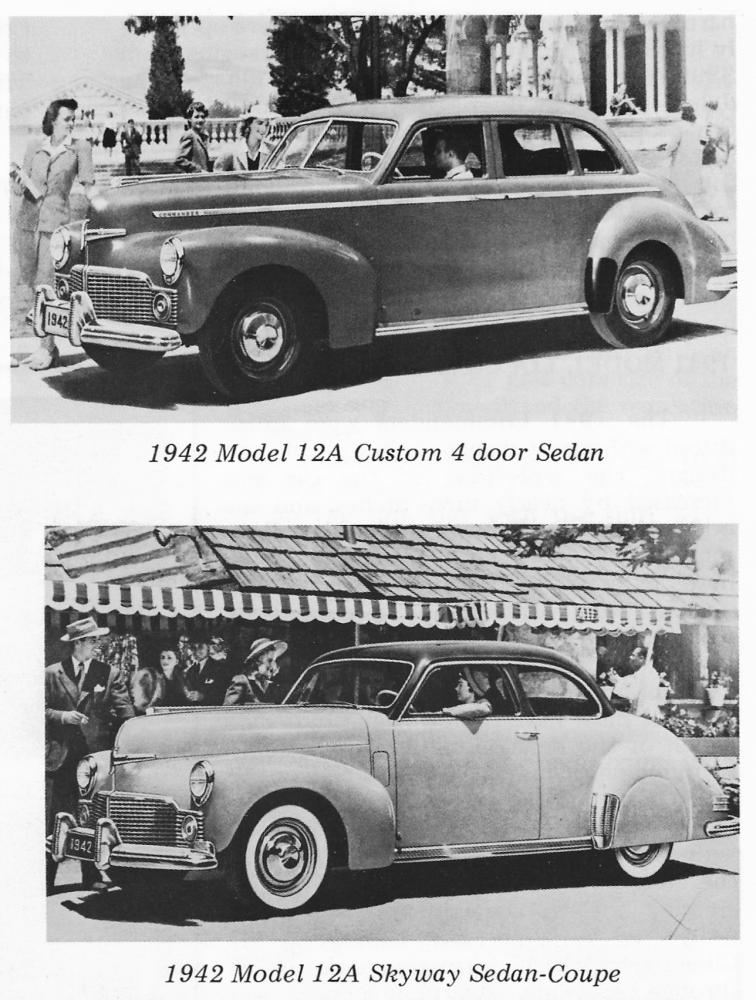 As
in 1941, there were three trim levels, Custom, Deluxestyle (replacing
Delux-tone), and Skyway. Each series had a Cruising Sedan, a Sedan
Coupe, and a Land Cruiser. As
in 1941, there were three trim levels, Custom, Deluxestyle (replacing
Delux-tone), and Skyway. Each series had a Cruising Sedan, a Sedan
Coupe, and a Land Cruiser.
The
major trim differences are; Skyways have two-toned paint, rear fender
skirts, stainless moldings around the windows, and chrome
rear-fender gravel shields. They also sport a “Skyway Commander”
badge on the rear lower side of the hood, but do not have the full
length belt line molding found on the Deluxestyle and Custom lines,. Deluxstyle cars have wide stainless moldings below the side windows
and black rubber gravel shields. Custom have no window bright trim
and rubber gravel shields. Both Custom and Deluxestyle belt moldings
have “Commander” stamped in the front.
Tells
for 1942:
1942
Commanders have a new
stainless grille
that
covered the entire front of the car, with horizontal bars emphasized
and the vertical bars as background. The grill had two round blank
spots, below and slightly inboard from the headlights, used for
optional fog lights. Massive
new bumpers
and
bumper guards with built in licence plate holder front and back. Large
new horizontal tail lights,
wrapping around the rear fenders, inside large chrome housings, with
dual lamps, one for flashing indicators and the other for tail
light/brake light. New hood ornaments, trunk and hood badges, and
trunk handle were in place. Parking lights were found on top of the
front fenders in long chromed housings’. The
only bright work, not new for 1942, was the headlight rings.
Instrument
panels were redesigned and very attractive. The finish of the radio
grille was clear lucite. Seat bottoms were wider; upholstery and door
panels more luxurious. Dual sun visors, windshield wipers, and horns
were standard on all models. Deluxestyle models had a front seat back
garnish trim panel with ashtray and two courtesy lights, as well as
three chrome moldings on the inside door panels, and two-tone
exterior and interior colors and trim. Skyway models had bolster
type pleated upholstery and Lucite door hardware panels.
Accessories:
Directional signals $19.25, radio and steering-wheel radio remote
control $70.25, rear-seat radio remote control (foot-activated button
mounted on the floor) $5.25. Just a few of the accessories offered
in 1942.
Mechanical:
Few changes were made, however Commanders were equipped with
Autolite ignition, and the starter button moved from the dash, too
under the clutch pedal, like the 1941 Champions.
Side
Bar:
1942
Turbo-matic
Drive. This innovation consisted of a fluid coupling, an automatic
vacuum-operated clutch, and a conventional three-speed transmission
with kickdown overdrive. The clutch pedal was eliminated, and gear
shifting was reduced to a minimum. Only six cars were actually
equipped with a Turbo-matic, three were Presidents and three
Commanders. It is not known whether any were ever released to the
public. By the time World War II was over, real fully automatic
transmission technology was available and this transmission design
never used.
BlackOut
Cars:
All
Studebaker cars built on or after January 16, 1942, were considerably
altered in appearance. This was the result of the government attempt
to conserve certain critical metals like chromium, nickel,
and stainless steel by requiring most brightwork to be eliminated on
all American cars. Studebaker referred to these cars as "series
90". In order to provide vehicles that would approximate
their glittery predecessors, Studebaker used noncritical metals like
Indium silver, and utilized baked-enamel finishes in colors that
would offer pleasing contrast to that of the body. Production of the
series 90 Commanders, during the last two weeks of January 1942 was
1,688. Surviving examples are quite rare.
| When data was available from TW or STCS (Studebaker the Complete Story) it is used. Else, TCCD (The Classic Car Database) & SCAC (The Standard Catalog of American Cars) is used. →Information found between the arrows is from Turning Wheel feature articles written by Fred Fox← What we can be fairly sure of is that the same body styles, depending on the source, were sometimes listed in different terms. SB= South Bend, LA= Los Angles, and CAN= Canada |
Model |
Doors |
Passenger |
Price |
| 1942 Model 12A Commander |
| Custom four-door Cruising Sedan (W3) |
4 |
6 |
$1,045.00 |
| Deluxestyle four-door Cruising Sedan (W5) |
4 |
6 |
$1,090.00 |
| Skyway four-door Cruising Sedan (W7) |
4 |
6 |
$1,125.00 |
| Custom Land Cruiser (B1) |
4 |
6 |
$1,080.00 |
| Deluxestyle Land Cruiser (B3) |
4 |
6 |
$1,125.00 |
| Skyway Land Cruiser (B7) |
4 |
6 |
$1,160.00 |
| Custom Sedan-Coupe (F3) |
2 |
6 |
$1,025.00 |
| Deluxestyle Sedan-Coupe (F5) |
2 |
6 |
$1,070.00 |
| Skyway Sedan-Coupe (F7) |
2 |
6 |
$1,105.00 |
| As we were unable to find a TW article for 1942 Commanders, the data show above was taken from SCAC which indicated that production started in August of 1941 and ended in January of 1942. They fixed production at 17,500 units. According to STCS the starting serial numbers for 1942 Commanders is 4,216,501 for SD and 4,816,601 for LA. No ending serial numbers are listed, so production cannot be calculated from the serial numbers. However, if you look at the starting serial numbers for 1947 Commanders for SB and LA, 4,232,501 & 4,818, 501 respectively, it would appear that 17,900 1942 serial numbers were assigned, slightly more then the 17,500 production number reported by SCAC. The starting Engine Number is H-164,301, the ending number is not listed. However, 1947 Commander Engine Numbers start at H-182,001 so most likely 17,700 Engine Numbers were assigned to 1942 Commanders. Interestingly TCCD, while listing the exact same model line-up, also listed each models price at exactly $83.00 more, leading us to wonder if a price increase was initiated some time during production. |
|
|
|
|
|
|
|
|
 |
|